
Pigs are omnivores and are intelligent animals. With around 1 billion individuals alive at any time, the domesticated pig is one of the most numerous large mammals on the planet. The meat of pigs is widely eaten by people across the world.
Breeds of Pigs
There are the following breeds of Pigs:
|
 Aksai Black Pied Aksai Black Pied
|
|
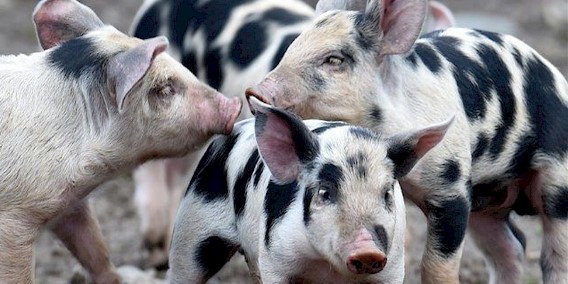
|
In the wide expanse of the Kazakh steppes, where the winds whisper tales of ages past, roams the Aksai Black Pied pig. A creature as rugged as the land it calls home, with a coat that paints a picture of contrasts in black and white, a living mosaic amidst the grassy plains.
This breed, born of necessity in the nomadic tribes of Kazakhstan, carries a history as rich as the soil it roots upon. For generations, it has been the steadfast
...
|
|
 American Landrace American Landrace
|
|

|
The various strains of American Landrace swine are the descendants of
the famous Danish Landrace hogs that were developed in Denmark in the 1890s.
It resulted from crossing the Large White hog from England with the native
swine. Largely through the use of the Landrace Denmark became a great
bacon-exporting country.
In the early 1930s the United States Department of Agriculture entered
into an agreement with the Ministry of Foreign
...
|
|
 American Yorkshire American Yorkshire
|
|
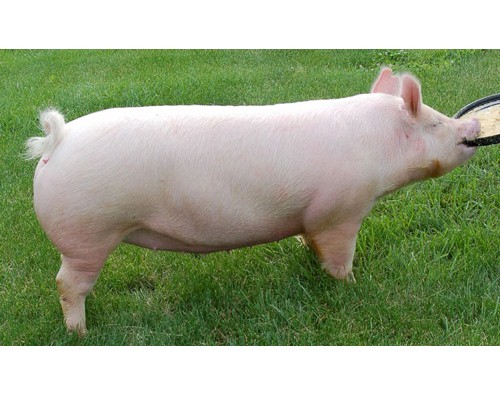
|
The American Yorkshire is a breed of domestic pig and
is the American version of the Yorkshire pig (now known as the English Large
White pig). Yorkshire pigs are white and have erect ears. The modern Yorkshire
is very muscular, with a high proportion of lean meat and low backfat. They are
also very sound and durable animals. Yorkshires are classified into three
types: large, middle, small. Only the large type of Yorkshire pig has ever
gaine
...
|
|
 Angeln Saddleback Angeln Saddleback
|
|
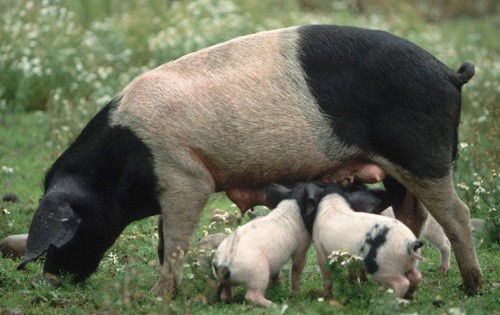
|
The Angeln Saddleback is a large, lop-eared, black pig
with a white band around its body which continues down to its forefeet. They
typically weigh 350 kg weight, 92 cm height (boars) and 300 kg weight, 84 cm
height (sows).
The Angeln Saddleback pig, also known as the Angler
Sattelschwein, is a rare breed of domestic pig came from Angeln, a region of northern Germany.
In 1937 a black-and-white landrace was crossed with
...
|
|
 Appalachian English Appalachian English
|
|
|
In the heart of the Appalachian Mountains, amidst the rolling hills and verdant valleys, roamed the Appalachian English pig. Born of the rugged terrain and nurtured by generations of Appalachian settlers, these pigs embody the resilience and spirit of the land they call home.
Originating from the fertile soil of Appalachia, these pigs were not merely livestock but companions in the harsh realities of homesteading life. For over two cen
...
|
|
 Arapawa Arapawa
|
|
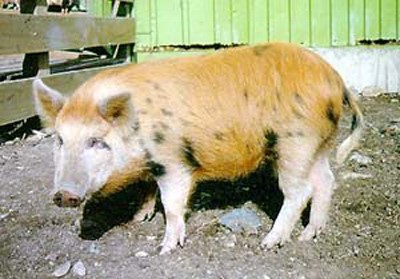
|
Arapawa Pigs are a
large hairy breed. They are either a tan or sandy color with black patches.
Arapawa Pigs are a feral breed of domestic pig found on Arapawa in the Marlborough Sounds of New Zealand, where
they have lived since 1839.
The boars weigh
120-180 kg, and the sows 80-100 kg. Although there are suggestions
that the animals are descendants of pigs introduced to the area by James Cook
in 1773 and 1777, it is m
...
|
|
 Auckland Island Auckland Island
|
|
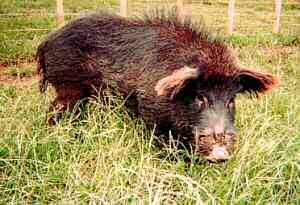
|
The Auckland Island Pig is a feral breed of domestic pig found on
Auckland Island in New Zealand.
The pig is believed to have inhabited the island since 1807, when
Europeans made several various releases of domestic pigs to provide a source of
food for stranded sailors or visiting whalers. By the end of the 19th century,
the island held a thriving population of mixed origin pigs. In the late 20th
century the largely undisturbed pi
...
|
|
 Ba Xuyen Ba Xuyen
|
|
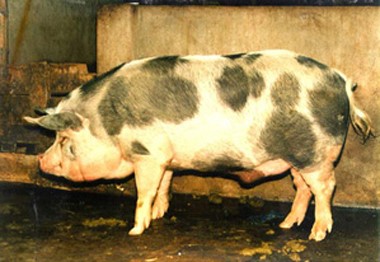
|
Ba Xuyen is a combination of French and
Chinese swine from composites of the Craonnais, or Bo Xu. These mut hogs were imported
around 1920, by French planters, and the Chinese pigs imported around 1900, by
Chinese traders. The Ba Xuyen is primarily found in South Vietnam along the
Mekong River delta. They have adapted well to the salty-water zones of that
area. The Ba Xuyen has a high backfat thickness that is usually around 42 mm
and it we
...
|
|
 Babi Kampung Babi Kampung
|
|
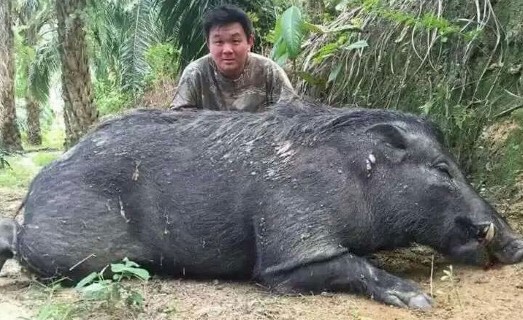
|
Babi Kampung, also known as "village pig," is a traditional breed of pig that is found in Indonesia. They are known for their hardiness and adaptability, as well as their ability to forage for food in the wild. Babi Kampung pigs have a black or dark brown coat, a large body, and a broad snout. They are known for their meat which is considered to be more flavorful and tender than commercial breeds. They are mostly raised by smallholder farmers and
...
|
|
 Bamaxiang Bamaxiang
|
|
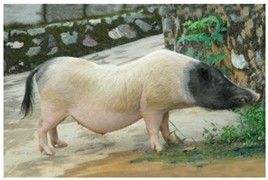
|
Bamaxiang pigs, also known as Bama Black pigs, are an indigenous breed of domestic swine originating from the Bama Yao Autonomous County in Guangxi Zhuang Autonomous Region, China. They are characterized by their distinctive black coloration, compact build, and hardy temperament.
Size: Bamaxiang pigs are considered medium-sized hogs, typically weighing between 180 and 230 kilograms (397 and 507 pounds) at maturity.
The
...
|
|
 Bantu Bantu
|
|
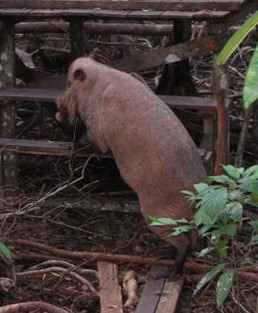
|
The Bantu is found in southern Africa, and is derived from early breeds of swine from Europe and Asia. Bantus are usually brown but can also be black and white with splotches of black spots.
They are known for their hardiness, adaptability and ability to forage for food in the wild. They are known for their meat which is considered to be more flavorful and tender than commercial breeds. They are mostly raised by smallholder farmers and
...
|
|
 Basque Basque
|
|
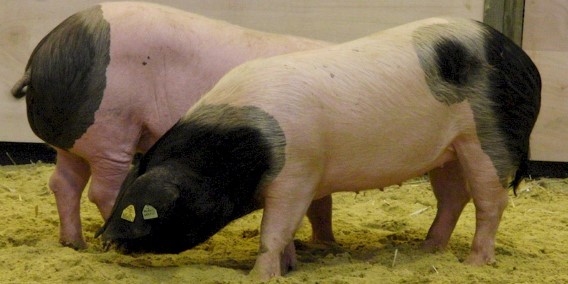
|
Basque pigs are a
breed of swine from Basque Country, France. They are piebald, black and pink.
What is today
called the Basque pig is one of several historical breeds or breed types kept
by the Basque peoples, and it was consolidated under the name only in the
1920s. Though they were relatively common in the early 20th century, Basque
pigs had nearly disappeared by 1981, with fewer than 100 breeding sows left.
Today, t
...
|
|
 Bazna Bazna
|
|
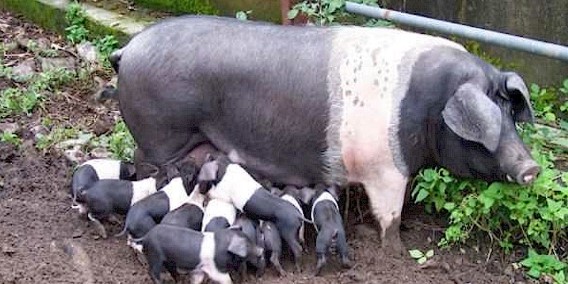
|
The Bazna is a pig
originally from the Transylvania region of Romania, and they are in
fact not vampires.
The Bazna pigs are black with a
white belt, medium withers height and body structure, and typically weighing
125 to 135 kilograms by their first year. They are mainly bred for their lard
and lean meat.
The Bazna dates back to 1872, when they were created from crossing the
Berkshire and Mangalitsa pig breeds. The o
...
|
|
 Beijing Black Beijing Black
|
|
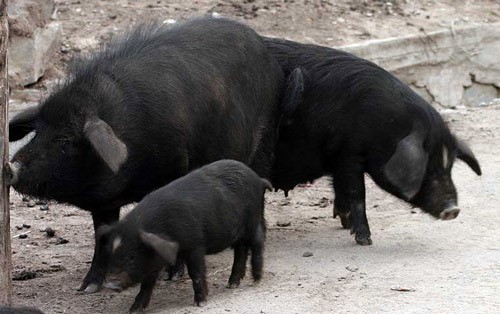
|
The Beijing Black Pig breed, widely distributed across China, is primarily recognized for its role as a meat-producing breed, characterized by a predominantly black coat adorned with occasional white markings. Its development dates back to 1962 when it originated from a selective crossbreeding program. This program aimed to enhance the breed's attributes by incorporating genetic contributions from the Berkshire and Large White breeds, alongside l
...
|
|
 Belarus Black Pied Belarus Black Pied
|
|
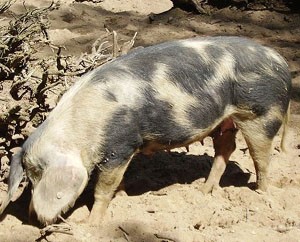
|
Belarus Black Pied Pigs are bred in the region surrounding Minsk in the Republic of Belarus, Eastern Europe. They are a meat and lard breed which was developed from Large White, Large Black, Berkshire, and Middle White breeds crossed with various local breeds in the late 1800''s and in the 1920s.
They are known for their hardiness, adaptability and ability to forage for food in the wild. They are medium-sized, with a black and white c
...
|
|
 Belgian Landrace Belgian Landrace
|
|
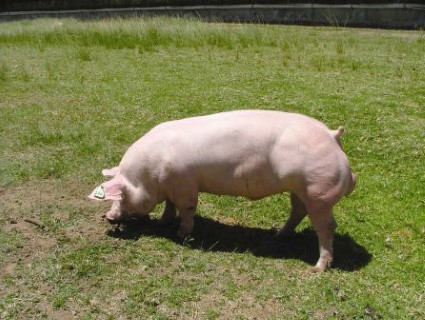
|
The Belgian
Landrace is a muscular white swine with heavy droopy ears. They are known as
the butchers pig, primarily because they are the most commonly used breed for
the consumer market. The Belgian Landrace can be described as a very practical
type of pig with good fertility, sound body mechanics, and good maternal
instincts, and plenty of milk for their piglets.
The Belgian
Landrace has met the demands of producing top qualit
...
|
|
 Bengali Brown Shanna Bengali Brown Shanna
|
|
|
Bengali Brown Shannaj pig is a traditional breed of pig that is native to the region of Bengal, India. They are known for their hardiness, adaptability and ability to forage for food in the wild. Bengali Brown Shannaj pigs have a brown coat, a large body, and a broad snout. They are known for their meat which is considered to be more flavorful and tender than commercial breeds. The breed is also known to be efficient in converting feed into meat,
...
|
|
 Berkshire Berkshire
|
|
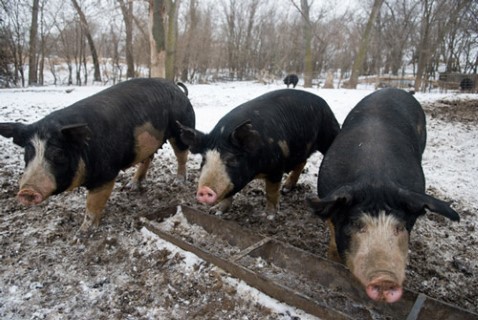
|
Berkshire are a small black pig
with prick ears, white socks, white tip to tail and flash on their face.
During the 19th Berkshire pigs
became very popular. Berkshire were soon exported to the USA. This trend
continued throughout the century and by the end of the 19th century, herds were
also established in Australia and New Zealand. Up until the first half of the
20th century, the breed grew in popularity. However, as with all co
...
|
|
 Bisaro Bisaro
|
|
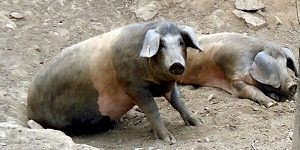
|
Bisaro pigs, a cherished heritage breed originating from Portugal, boast a captivating range of colors, spanning from a deep, velvety black to a delicate, almost ethereal pink hue, with some individuals showcasing enchanting variations in between. Their distinctive convex dorsal line lends them an elegant and robust appearance, adding to their allure.
Mature Bisaro pigs typically reach heights of up to 95 centimeters, standing proudly
...
|
|
 Black Canary Black Canary
|
|
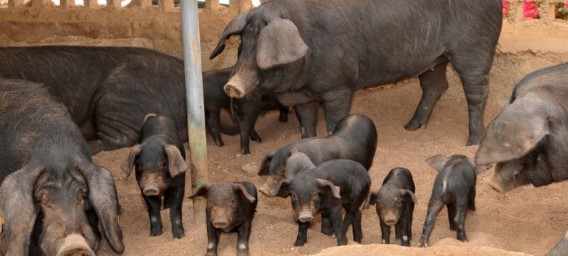
|
The Black Canary Pig, native to the Canary Islands, is a breed celebrated for its striking black coat, which distinguishes it in the world of swine husbandry. Renowned for its exceptional meat quality, the Black Canary Pig holds a revered status in the culinary realm, where its meat is highly sought after for its premium taste and tenderness.
This esteemed breed has garnered recognition not only locally but also on a global scale. Its
...
|
|
 Black Salvonian Black Salvonian
|
|
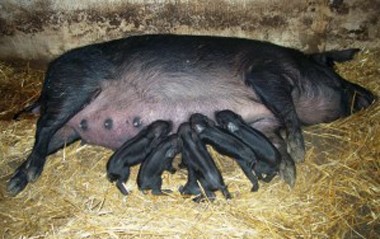
|
The Black Salvonian, a breed teetering on the brink of extinction, emerges as a poignant tale from the annals of Croatian pig breeding, celebrated for its delectable meat. This unique porcine lineage found its genesis at the confluence of the 19th and early 20th centuries through a meticulous fusion of the Mangulica, Berkshire, and Poland China pig breeds. Each of these ancestral contributors bestowed upon the Black Salvonian distinctive traits,
...
|
|
 Blue wild Blue wild
|
|

|
Blue wild pigs
were reported in North Canterbury, New Zealand, in the early twentieth century.
A 1922 publication noted: Perhaps the most interesting specimen of the
wild pig in this Dominion is the blue pig found in the Mount Grey and Karetu
districts, North Canterbury. The blue color is produced by a blend of
apparently equal numbers of white and black hairs. So fixed is the type that
blue pigs may be found in a litter with blacks or blac
...
|
|
 Breitovo Breitovo
|
|
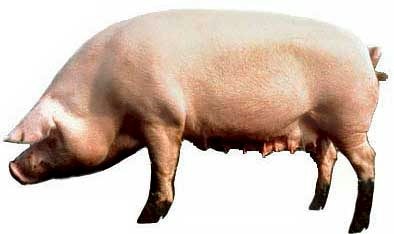
|
Breitovo pigs are a general purpose swine from Russia. They were bred in
the Yaroslavl region as a result of crossing local pigs with Danish landrace,
large white and medium white breeds of pigs. They became widespread in the
north-west of Russia, in the Volga region, and in the Urals. They were taken
out against a background of voluminous feeding with a large quantity of
potatoes.
They are predominantly white, but some have darker sk
...
|
|
 British Landrace British Landrace
|
|
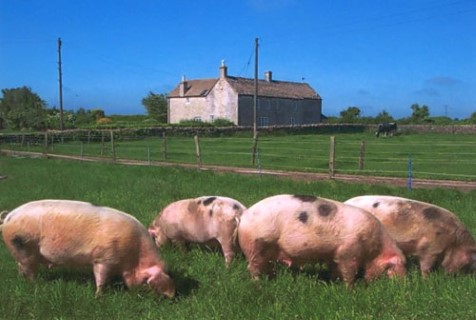
|
The
first Landrace pigs were imported into Britain from Sweden in 1949. In 1950,
the British Landrace Pig Society was formed to create a herd book for the first
offspring born and very soon an evaluation scheme was created. The first pig
testing scheme was for daily gain and fat depths, a testing station was built
at Stockton-on-Forest, York. This was one of the first examples of pig testing
in the UK.
Starting
in 1953, more Lan
...
|
|
 British Lop British Lop
|
|
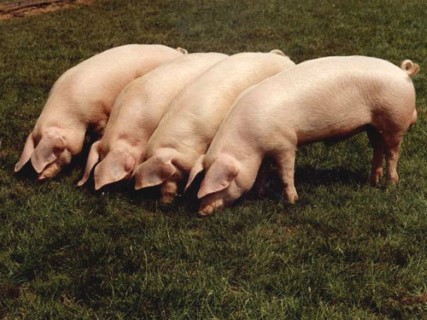
|
The British Lop Pig is a descendent of the lop-eared white pigs that
lived in the southwest English farmyards for centuries.
The breed society was formed in 1920 under the name of the National Long
White Lop- Eared Pig Society. The name was changed to the British Lop Pig
Society in the 1960s.
As with most of the other rare breeds the
decision in the 1950s to concentrate pig production on just three breeds
(Landrace, L
...
|
|
 British Saddleback British Saddleback
|
|
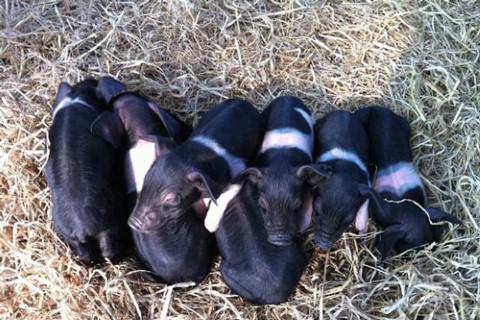
|
British
Saddleback pigs are a breed of domestic pig created in the 20th century from
the cross-breeding of Essex and Wessex Saddleback breeds.
In
the 20th century Lord Western, while travelling in Italy, saw some Neapolitan
pigs and decided thatthey were just
what he needed to improve the breed of Essex pigs. He bought a pair of
Neapolitan boars and crossed them with Essex sows. One Lord Westerns tenants
named Fisher Hobbs of Bo
...
|
|
 Bulgarian White Bulgarian White
|
|
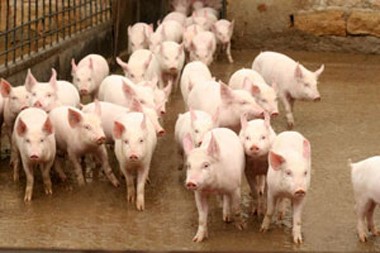
|
In the early 1960s, the Bulgarian government embarked on a mission to enhance the meat productivity of the nation's indigenous Bulgarian White pig breed. To achieve this objective, they implemented a strategic plan involving the importation of 3,000 high-quality pedigree breeding stock from various countries, including the USSR, Sweden, and Poland. These imported pigs, primarily of Landras and Large White varieties, were deemed crucial for their
...
|
|
 Calabrese Calabrese
|
|

|
The origin of the Black Pig from Calabria remains shrouded in mystery, with two prevailing hypotheses circulating today. One theory suggests its roots trace back to Iberian stock, while an alternative narrative posits its descent from Roman lineage. Historically, these pigs roamed vast expanses of Calabria, where they diversified into several distinct local varieties, including Reggitana, Cosentino, Orielese, Lagonegrese, Catanzarese, Casalinga,
...
|
|
 Cantonese Cantonese
|
|
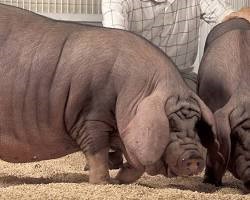
|
Cantonese pigs, also known by various names including Dahuabai, Ta-hua-pai, Kanton, Chinese, Gongdong Big Spotted, Guangdong Large White Spot, Large Black White, Macao, or Pearl River Delta pigs, are a distinguished breed originating from the fertile Zhujiang delta in Guangdong, China. Revered for their dual-purpose utility in lard and meat production, these pigs exhibit a striking black and white coloration, adding to their visual allure.
<
...
|
|
 Casertana Casertana
|
|

|
The Casertana
breed has very ancient origins (Teano or Pelatella): in fact it is
frequently represented in frescoes and sculptures of Roman times. It is
certainly the most precocious among Italian breeds, being able to give large
amounts of fat. At the age of one year these pigs may weigh over 150 kg. The
present situation about this breed is crucial, as only few examples still live,
and not all of them are full-blooded. Rustic, excellent
...
|
|
 Celtic Celtic
|
|
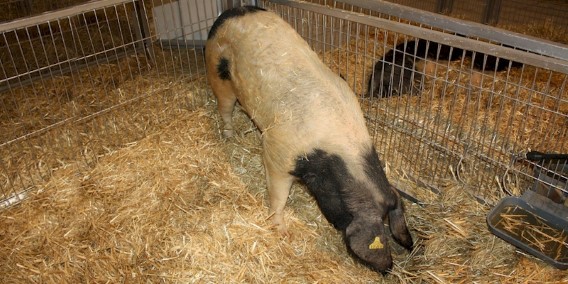
|
The Celtic pig (Galician: Porco celta) is a distinguished breed native to the autonomous community of Galicia in north-western Spain. While once abundant until the early 20th century, Celtic pigs faced a significant decline, nearly vanishing altogether. However, concerted efforts have led to their gradual recovery, with the population now boasting over 2,500 purebred sows.
|
|
 Chato Murciano Chato Murciano
|
|
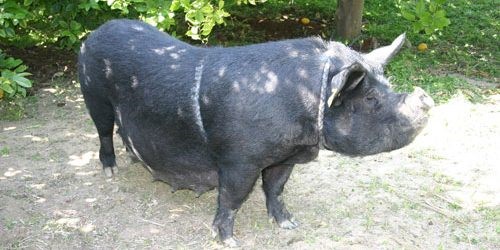
|
Chato Murciano
pigs are domestic pigs from Murcia, Spain. The Spanish word chato means short-nosed which is how these short-nosed pigs from Murcia got their name.
They are the only surviving breed of pig locally and historically produced in
Murcia and they are at the risk of extinction.
Chato Murciano
pigs are generally bred for bacon and lean pork and they are well adapted to
southern Spains dry and warm climate.
Alo
...
|
|
 Chester White Chester White
|
|
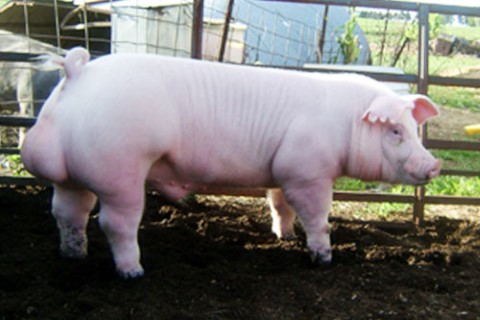
|
Chester White
pigs originated in Chester County, Pennsylvania. The Chester White was first
developed around 1816, using strains of large white pigs common to the
Northeast U.S. and a white boar imported from Bedfordshire. Some believe
that Chinese pigs might have been added as well.
By 1884 a breed association
was officially formed, but competing organizations, sometimes for individual
strains, continued to appear into the early
...
|
|
 Choctaw Hog Choctaw Hog
|
|
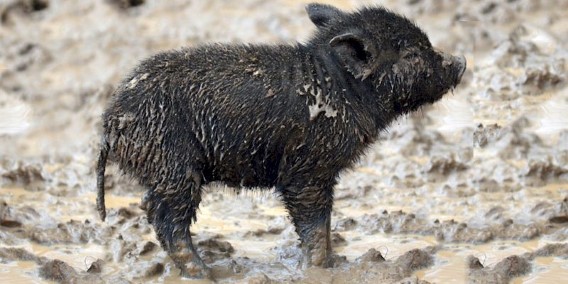
|
Choctaw Hog are
domestic pig raised by Native Americans for meat. Unfortunately there are only
a few hundred left and are considered critically rare.
Choctaw hogs are
black, sometimes with white markings, and grow to about 120 pounds. Choctaw
hogs have two distinctive characteristics: their toes are typically fused
forming a single hoof like that of a mule, and many have fleshy wattles on each
side of their necks.
Cho
...
|
|
 Cinta Senese Cinta Senese
|
|

|
The Cinta Senese is a venerable breed with a rich history originating in the Siena area, specifically around Monteriggioni, Sovicille, and Poggibonsi. Its legacy traces back to the 14th century, as depicted in frescoes portraying pigs adorned with the distinctive white belt reminiscent of present-day Cinta pigs. At its peak, approximately 20,000 Cinta Senese pigs roamed the region, with an equal number thriving in neighboring provinces.
|
|
 Creole Creole
|
|
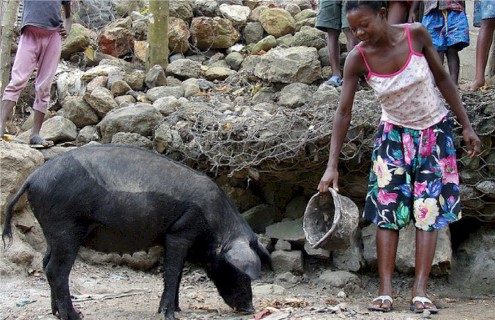
|
The Creole Pig
was a breed of pig indigenous to the
Caribbean nation of Haiti. Creole pigs are
well adapted to the rugged terrain and sparse vegetation of Haiti. The pigs
resilience allowed Haitian peasants to raise these pigs with little resources.
The peasants characterized their pigs as
never getting sick.
For generations,
the Haitian Creole pig had been a poor Haitian familys most important economic
asset. Rugged foragers t
...
|
|
 Cul Noir Du Limousine Cul Noir Du Limousine
|
|
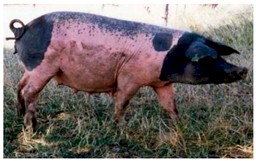
|
Cul Noir Du Limousine pigs, also known as "Black Limousin" pigs, are a rare breed of swine originating from the Limousin region of France. They are characterized by their distinct black and white markings, their compact build, and their docile temperament. Cul Noir Du Limousine pigs are classified as medium-sized hogs, typically weighing between 200 and 250 kilograms (441 and 551 pounds) at maturity. Their build is compact and muscular, with a sl
...
|
|
 Cumberland Cumberland
|
|
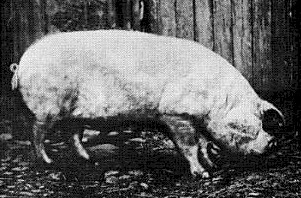
|
Cumberland Pigs
were a pig from Northern England that are now extinct. They were used to
produce local delicacies like the Cumberland sausage and Cumberland ham. The
breed became extinct in 1960, after changes in farming methods and a demand for
less fatty meat led to it falling out of favor.
Cumberland Pigs
were a very old breed that likely developed over several hundred years in
Cumberland and Westmorland, and was closely
...
|
|
 Czech Improved White Czech Improved White
|
|
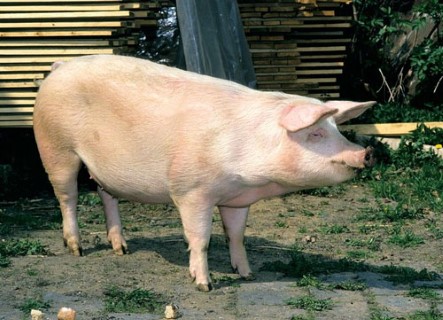
|
Czech Improved White Pigs, a staple across the Czech Republic, trace their lineage to a meticulous blend of Large White, Edelschwein, and German Landrace pigs, carefully crossed with indigenous swine breeds. This strategic amalgamation resulted in a versatile porcine lineage that not only thrives in diverse environments but also serves as the progenitor for subsequent breeds like the Slovakian Improved White and Slovakian White Meat.
C
...
|
|
 Danish Landrace Danish Landrace
|
|

|
Danish Landrace pigs are a medium to large white
breed of pig. They have long bodies, fine hair, long snouts, and heavy drooping
ears. There are two distinct varieties, the white and the piebald.
The first registered Landrace herd was
established in 1896 in Denmark, with the first progeny and sibling tests in
1907. Since then, production and quality testing have become a regular part of
the Danish swine improvement program. Primar
...
|
|
 Danish Protest Danish Protest
|
|
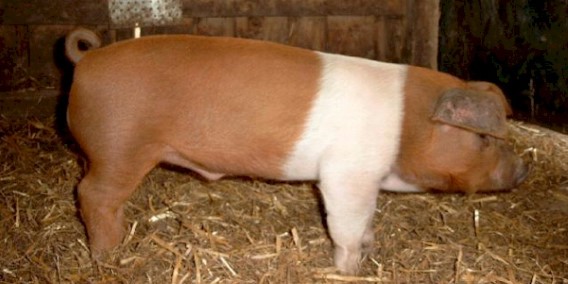
|
The Danish Protest Pig is a rare breed of
domestic pig. Due to its red color, its broad white vertical belt, and a trace
of a white horizontal belt it resembles the colors of the Flag of Denmark. It
originated in North Frisia in Southern Schleswig in the beginning of the 20th
century, when Danes living in the area were not allowed to raise the Danish
flag and kept and displayed the Protest Pig instead, making it a symbol of
their cultural i
...
|
|
 Dermantsi Pied Dermantsi Pied
|
|
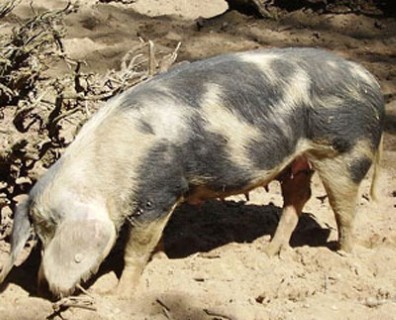
|
Dermantsi Pied Pigs, alternatively referred to as Pstra dermanska, Dermantsi Black Spotted, Dermanska chernosharena, or Schwarzbuntes Dermanzi, grace the picturesque landscapes surrounding Lukovit in the enchanting northern region of Bulgaria. These remarkable pigs, known for their multifaceted utility, particularly excel as lard pigs, embodying a rich heritage deeply intertwined with the local agricultural traditions.
Adorned in a cap
...
|
|
 Deutsches Weideschwein Deutsches Weideschwein
|
|
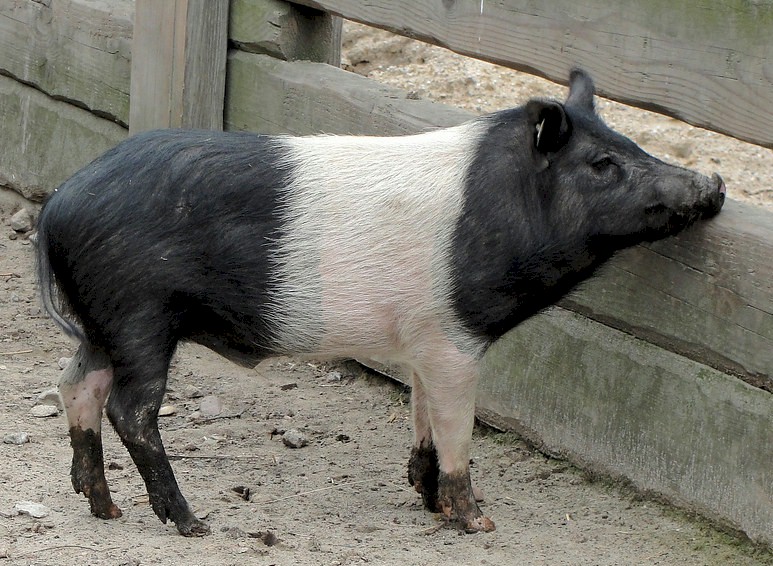
|
Deutsches Weideschwein pigs, also known as German Pasture Pigs or German Forest Pigs, are an ancient breed of domestic swine originating from the forests and meadows of Germany. They are characterized by their distinctive black and brown coloration, hardy constitution, and adaptation to outdoor rearing.
Deutsches Weideschwein pigs are considered medium-sized hogs, typically weighing between 200 and 300 kilograms (441 and 661 pounds)
...
|
|
 Ding'an Ding'an
|
|
|
Ding'an pigs, also known as Dinghu pigs, are an indigenous breed of domestic swine originating from the Ding'an County in Hainan Province, China. They are characterized by their distinctive black and white markings, compact build, and gentle temperament.
Ding'an pigs are considered medium-sized hogs, typically weighing between 180 and 250 kilograms (397 and 551 pounds) at maturity. Boars tend to be slightly larger than sows.
...
|
|
 Dongshan Dongshan
|
|
|
Dongshan pigs, also known as Dongan pigs, are an indigenous breed of domestic swine originating from the Dongshan County in Fujian Province, China. They are characterized by their distinctive black and white markings, compact build, and hardy temperament.
Dongshan pigs are considered medium-sized hogs, typically weighing between 150 and 200 kilograms (331 and 441 pounds) at maturity. Boars tend to be slightly larger than sows.
<
...
|
|
 Dutch Landrace Dutch Landrace
|
|
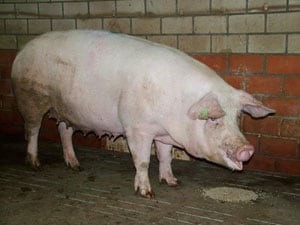
|
Dutch Landrace Pigs are a
combination of German Landrace and Danish Landrace pigs. They are found in the
southern, eastern, and northern parts of Holland. They are a meaty and
efficient breed of pig.
Dutch Landrace pigs have the same general look
as other Landrace breeds. They are white and they have large floppy ears. They
have been developed to have bigger backs and heavier hams than found on other
types of Landrace pigs. They
...
|
|
 East Balkan East Balkan
|
|
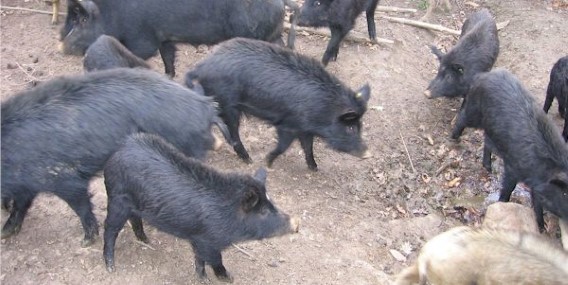
|
East Balkan Pigs, also known as East Balkan Swine (EBS), stand as a rare and treasured gem, representing the sole indigenous domesticated pig breed of Bulgaria. Their exclusive distribution spans the scenic western coast of the Black Sea, where they have carved out a niche as resilient custodians of Bulgaria's rich agricultural heritage.
In 2009, the population of East Balkan Pigs numbered 1,858, a testament to their enduring presence
...
|
|
 Essex Essex
|
|
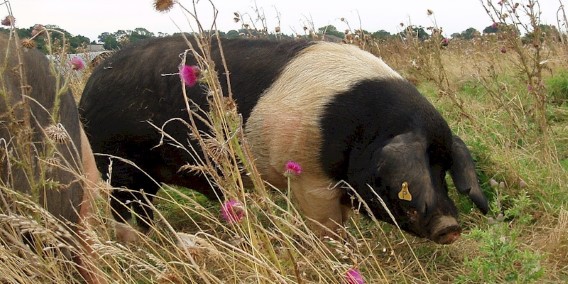
|
Essex pigs were developed in the United
Kingdom. Essex pigs are popular because they are easy and cheap to keep.
The modern day Essex was developed by
breeding local pigs in area denoted in the Essex area. The original Essex, also
known as the Old Essex, was a small black and white pig. By the nineteenth
century, the Old Essex was improved by crossbreeding with imported pig breeds.
Although the breed had been changed, they
sti
...
|
|
 Estonian Bacon Estonian Bacon
|
|
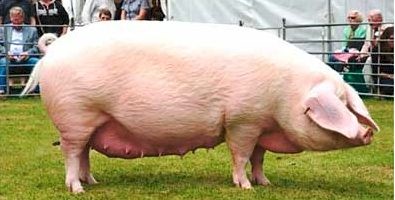
|
Estonian Bacon pigs, a quintessential breed from the rugged landscapes of Estonia, represent the epitome of meat production, renowned for yielding exceptional bacon that tantalizes the taste buds. Born from a fusion of local landrace pigs with esteemed German, Danish, and Swedish counterparts, these pigs embody a rich heritage of genetic diversity and culinary excellence.
With a striking resemblance to their Danish Landrace counterpart
...
|
|
 European Wild European Wild
|
|

|
The European Wild Boar, commonly referred to as the Euro in New Zealand, is renowned for its hardy nature and resilient demeanor.
Believed to be the ancestral progenitor of all domesticated pigs, including Asian varieties, the European Wild Boar boasts a storied lineage that extends across continents.
Despite the formidable reputation of its wild counterpart, domesticated Euros exhibit gentle and amiable traits, making them
...
|
|
 Fengjing Fengjing
|
|
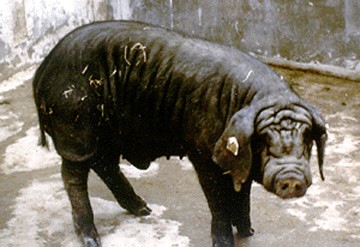
|
Fengjing pigs are
from the town of Fengjing in Shanghai, China. They are mainly found in the
districts of Jinshan,Songjiang, and Wujiang. They are classified as a type of
Taihu pig which all occur in the narrow region of mild sub-tropical climate
around the Taihu Lake region.
Fengjing pigs are
large black pigs with large floppy ears. They are distinguished by their very wrinkly
faces and bodies. They are excellent breeders, produ
...
|
|
 Finnish Landrace Finnish Landrace
|
|
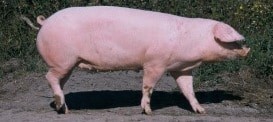
|
Finnish Landrace
pigs are found in abundance in the northern parts of Europe, particularly in
Finland. They have the same origin as the other Landrace pig breeds of Europe.
The Finnish Landrace pig breeds were developed by means of crossings with the
improved indigenous stock that were brought from other countries. They average
6 to 10 baby piglets in a litter and will have two to three litters per year.
Finnish Landrace
pigs hav
...
|
|
 Forest Mountain Forest Mountain
|
|
|
Forest Mountain pigs are an exceptionally rare breed native to the rugged terrain of Armenia, where they have roamed for generations. Regrettably, their population has dwindled to alarmingly low numbers, prompting concerns about the imminent threat of extinction.
Endowed with unique characteristics tailored to their mountainous habitat, Forest Mountain pigs possess a distinct genetic makeup that sets them apart from other breeds. Their
...
|
|
 French Landrace French Landrace
|
|
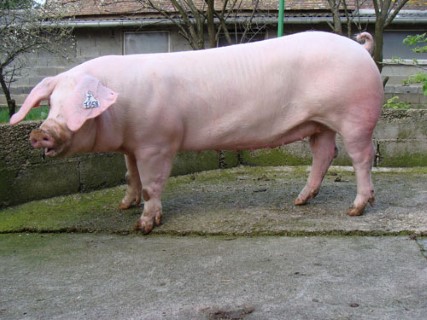
|
Landrace pigs made their initial appearance in France circa 1930; however, it wasn't until the post-World War II era that they experienced widespread importation into the country, primarily from Sweden.
The contemporary French variant of Landrace pigs is notably large and distinguished by their white coat and prominent heavy drooping ears. Through selective breeding, they have been refined to emphasize skeletal robustness, substantial
...
|
|
 Ganxi Ganxi
|
|
|
Ganxi pigs, also known as Jianxi pigs, are an indigenous breed of domestic swine originating from the Jiangxi Province in China. They are characterized by their distinctive black and white markings, compact build, and hardy temperament.
Ganxi pigs are considered medium-sized hogs, typically weighing between 180 and 230 kilograms (397 and 507 pounds) at maturity. Boars tend to be slightly larger than sows.
They have a compa
...
|
|
 Gascon Gascon
|
|
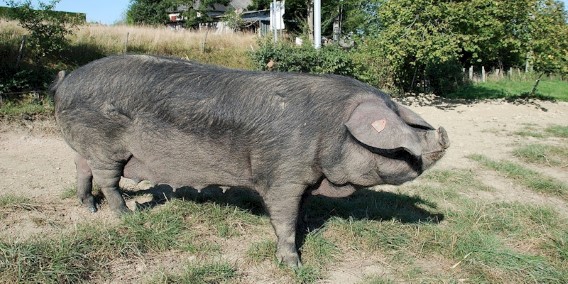
|
Gascon pigs are a rare breed from the
mountainous and remote regions of France, and they probably are the most ancient
breed of pig in France.
Despite endangered Gascon pigs have many
valuable characteristics. Like most old-fashioned breeds, they are prone to
becoming very fat, but they are vigorous, hardy, thrifty and tolerant of hot
climates. The sows are prolific and have a good supply of milk for their
litters.
|
|
 German Landrace German Landrace
|
|
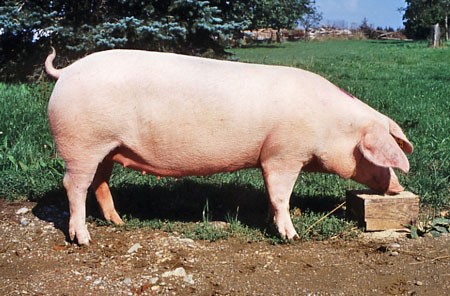
|
German Landrace pigs were developed around 1900,
in Lower Saxony, Germany from carefully selected pigs from the area. During the
years of 1948 to 1958, there were importations of Danish and Dutch Landrace
that were used to further improve the breed.
German Landrace pigs are very similar to other
Landrace pigs; they are white heavy drooping ears. However, they are not as
extreme in size and length as some of the Landrace strains o
...
|
|
 German Saddleback German Saddleback
|
|
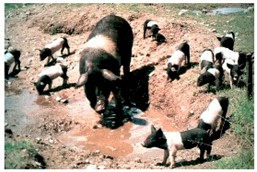
|
German Saddleback pigs, also known as "Deutsche Sattelschweine" or "Saddleback pigs" in Germany, are a rare breed of domestic swine originating from the Franconia region of Germany. They are characterized by their distinctive black and white saddle-like markings, compact build, and gentle temperament.
Size German Saddleback pigs are classified as medium-sized hogs, typically weighing between 200 and 250 kilograms (441 and 551 po
...
|
|
 Gloucestershire Old Spot Gloucestershire Old Spot
|
|
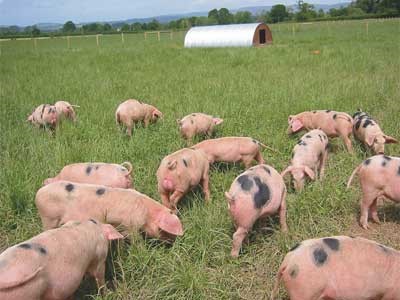
|
The Gloucestershire Old Spot pig, also affectionately known as the "Old Spots" or "Gloucester Old Spots," boasts a rich heritage rooted in the picturesque countryside of Gloucestershire, England. Renowned for their distinctive appearance and esteemed culinary qualities, these pigs have garnered acclaim both domestically and abroad.
With their endearing white coats adorned with large, distinctive black spots, Gloucestershire Old Spot pi
...
|
|
 Gloucestershire Old Spots Gloucestershire Old Spots
|
|
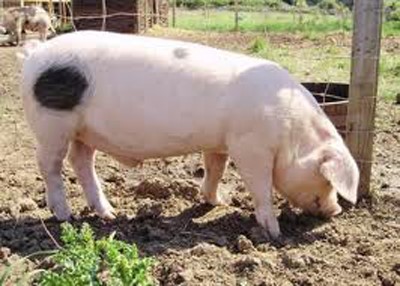
|
In the verdant landscapes of Gloucestershire County, England, roam the iconic Gloucestershire Old Spots Pigs, affectionately known as GOS hogs. Revered for their gentle demeanor, keen intellect, and remarkable fertility, these hogs epitomize the epitome of pastoral elegance and agricultural prowess.
With boars boasting a mature weight of 600 lbs (272 kg) and sows reaching 500 lbs (227 kg), Gloucestershire Old Spots Pigs command attenti
...
|
|
 Glowing Taiwanese Glowing Taiwanese
|
|
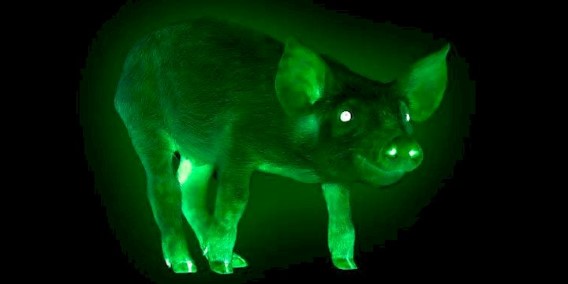
|
In Taiwan, they developed green luminous piglets. The goal of
their fluorescent cells is to help facilitate the work of geneticists.
Three green glowing male piglets were born thanks to the
efforts of scientists from the National Taiwan University. Professor Shin-Zhi
expressed the hope that their appearance will help in further research of stem
cells research.
Embryos with fluorescent green Jellyfish protein was
introdu
...
|
|
 Gochu Astrucelta Gochu Astrucelta
|
|
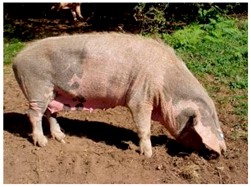
|
Gochu Astrucelta pigs, also known as Asturian Celta Pig or Celta Pig in Spanish, are an indigenous breed of domestic swine originating from the Asturias region of northwestern Spain. They are characterized by their distinctive black coloration, compact build, and rustic temperament.
Size: Gochu Astrucelta pigs are considered medium-sized hogs, typically weighing between 200 and 250 kilograms (441 and 551 pounds) at maturity.
|
|
 Gottingen Minipig Gottingen Minipig
|
|
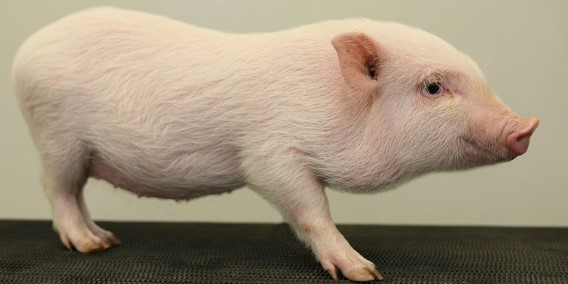
|
Gottingen Minipig (also known as the Gottinger or Goettingen Minipig) are a breed of miniature swine developed specifically for use in biomedical research. They arernbest known for their exceptionally small size and their very clean andrnwell-characterized health status. Their development began in the late 1960s atrnthe Institute of Animal Breeding and Genetics at the University of Gottingen, Germany, by crossbreeding Minnesota minipigs, the Viet
...
|
|
 Grafschaft Bentheim Grafschaft Bentheim
|
|
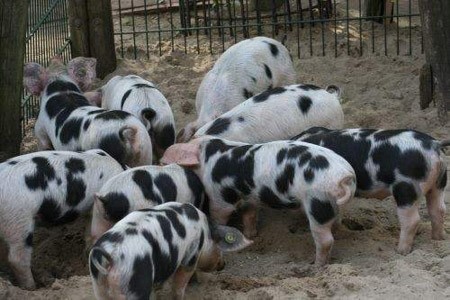
|
Originating in the Grafschaft
Bentheim area of northern Germany, the Bentheim Black Pied Pig is also known as
the Bunts Bentheimer Schwein, which is a mid-sized breed that is lop-eared with
white with black spots with grey rings. Their best traits are that they are
hardy and long-lived, with high fertility rates. They have an average of 9.2
pigs per litter. Boars average 75 cm height and 250 kg weight and sows average
70 cm height, 180 kg w
...
|
|
 Grice Grice
|
|
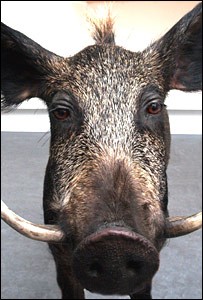
|
Grice Pigs, also known as the Highland,
Hebridean or Irish pig, are an extinct pig from Scotland and Ireland. They
became extinct, surviving longest in the Shetland Isles, where they disappeared
in the late nineteenth century.
Accounts from the early 19th
century suggest the grice was an aggressive animal with small tusks, an arched
back, and a coat of stiff dark bristles over a fleece of wool. Most likely
ranchers stopped breedi
...
|
|
 Guinea Hogs Guinea Hogs
|
|
|
Guinea Hogs, also known as Pineywoods Guinea, Guinea
Forest Hog, Acorn Eater, and Yard Pigs, are unique to the United States.
Despite their name, Guinea Hogs are not from the country of Guinea. The Guinea
Hog has a black coat, sturdy body, curly tail and upright ears.
Guinea hogs are very easy hogs to keep. They
are good as free-range foragers but they are also at home in a farmyard. If
farrowing is planned in the spring or summer
...
|
|
 Guizhong Spotted Guizhong Spotted
|
|
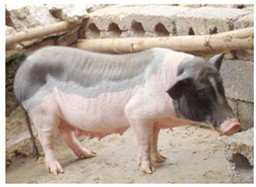
|
Guizhong spotted pigs, also known as Guizhou spotted pigs, are an indigenous breed of domestic swine originating from the Guizhou Province in China. They are characterized by their distinctive spotted coloration, compact build, and hardy temperament.
Guizhong spotted pigs are considered medium-sized hogs, typically weighing between 180 and 250 kilograms (397 and 551 pounds) at maturity. Boars tend to be slightly larger than sows.
...
|
|
 Hainan Hainan
|
|
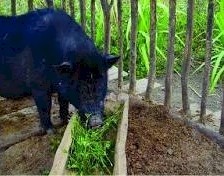
|
Hainan pigs, also known as Hainan black pigs, are an indigenous breed of domestic swine originating from the Hainan Province in China. They are characterized by their distinctive black coloration, compact build, and hardy temperament.
Hainan pigs are considered medium-sized hogs, typically weighing between 180 and 230 kilograms (397 and 507 pounds) at maturity. Boars tend to be slightly larger than sows.
They have a comp
...
|
|
 Hampshire Hampshire
|
|
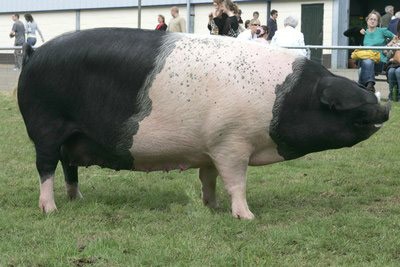
|
Hampshire pigs
have erect ears and are black with a whitish band around the middle, covering
the front legs. They are fourth most common breed of pig in the United States,
and probably the oldest American breed of hogs.
It is believed
that Hampshire pigs come from the Old English Breed, found in northern England
and Scotland. Most likely they were imported to America
from Hampshire England between 1827 and 1839.
Hamps
...
|
|
 Hereford Hereford
|
|
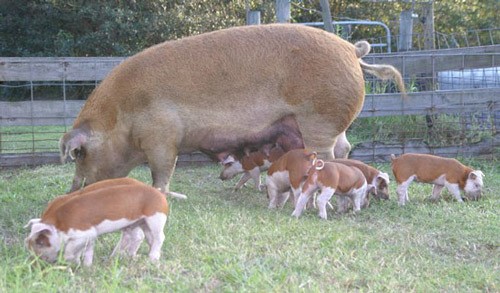
|
Hereford Pigs, also known as Hereford Hogs, are a rare breed of meat pigs originating from the United States. They bear a resemblance in coloration to Hereford cattle and were developed between 1920 and 1925 from a mix of Duroc, Poland China, and potentially some Chester White or Hampshire pigs. The official Hereford registry was established by 1934, marking their recognition as a distinct breed.
These pigs are renowned for their hardi
...
|
|
 Hezuo Hezuo
|
|
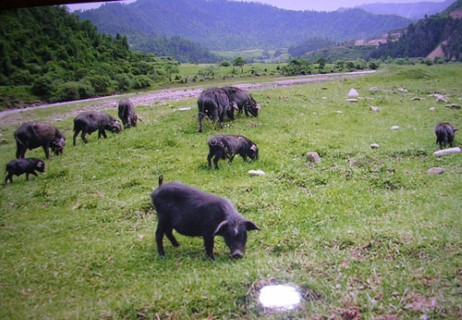
|
Hezuo Pigs are from China and
are found in the Gannan Tibetan Autonomous Prefecture of Gansu Province. They
are well suited to the region where the altitude in this region is high (2600
m), and the temperature low. The pigs are out on pasture year round, and are
characterized by long, coarse and dense bristles, a slow growth rate, and low
birth rate, with a litter size of 4 to 7.
|
|
 Huazhong Two-End Black Huazhong Two-End Black
|
|
|
Huazhong Two-end Black pigs, also known as Central China Two-end Black pigs, are an indigenous breed of domestic swine originating from the Hubei Province in China. They are characterized by their distinctive black coloration on both ends of their bodies, compact build, and hardy temperament.
Huazhong Two-end Black pigs are considered medium-sized hogs, typically weighing between 180 and 250 kilograms (397 and 551 pounds) at maturity.
...
|
|
 Iberian Iberian
|
|
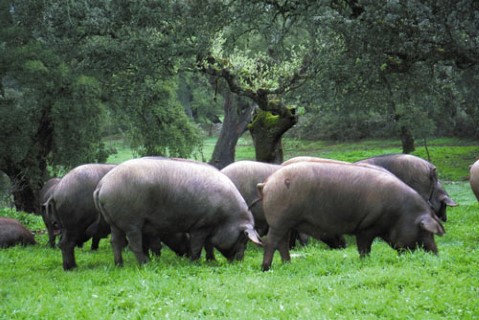
|
Iberian Pigs are
meat pigs from to the Iberian Peninsula. The Iberian pig can probably be traced
back to the Neolithic, when animal domestication started. Currently they are
found in herds clustered in the central and southern part of Portugal and
Spain.
The most commonly
accepted theory is that the first pigs were brought to the Iberian Peninsula by
the Phoenicians from the Eastern Mediterranean coast (current day Lebanon),
whe
...
|
|
 Idaho Pasture Idaho Pasture
|
|
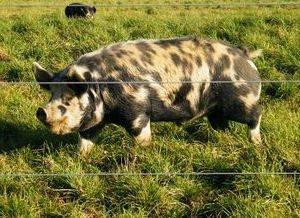
|
Idaho Pasture Pigs (also known
as IPPs) were developed from Duroc, Old Berkshire, and Kunekune pigs. They are
grazing pigs and are very gentle, have great personalities, are easy to work
with, and are smaller than traditional pig, like the Large White, while still
reaching a butcher weight of about 200 - 250 pounds in 9 - 10 months eating
primarily grass.
They are a well-proportioned
pig with a medium width in the leg set, a wide
...
|
|
 Italian Landrace Italian Landrace
|
|
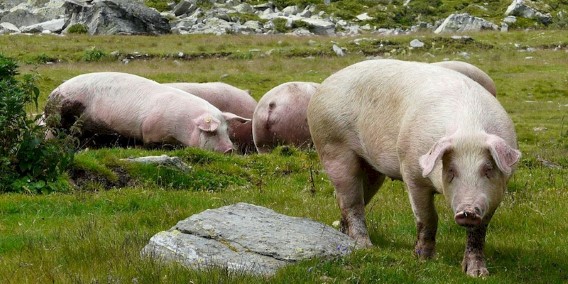
|
Italian Landrace Pigs represent a distinctive Italian variation of the Landrace pig breed. These pigs are characterized by their large size, remarkably long bodies, lop ears, and striking white coat.
Originally imported from Denmark in the post-Second World War era, Landrace pigs were specifically chosen for their suitability in the production of Salumi and prosciutto crudo, renowned dry-cured hams traditionally thinly sliced and serve
...
|
|
 Jeju Black Jeju Black
|
|
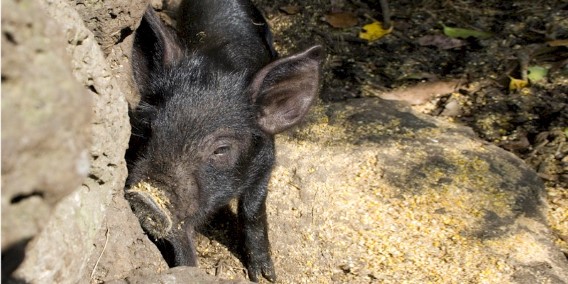
|
Jeju Black Pigs
are small black pigs found on Koreans largest island, Jeju-do. They have a
smooth coat of hair and erect unfolded, ears and a narrow snout.
Jeju Black Pigs
have a have a unique taste quite distinct from other breeds of pig and forms
the basis of some well-known local dishes. The pork is smoked over burning hay
allowing the smoke to penetrate the meat juices resulting in a flavor quite
unlike regular pork and a mea
...
|
|
 Jianli Jianli
|
|
|
Jianli pigs, also known as Jianli spotted pigs, are an indigenous breed of domestic swine originating from the Jianli County in Hubei Province, China. They are characterized by their distinctive spotted coloration, compact build, and hardy temperament.
Jianli pigs are considered medium-sized hogs, typically weighing between 180 and 230 kilograms (397 and 507 pounds) at maturity. Boars tend to be slightly larger than sows.
Th
...
|
|
 Jinhua Jinhua
|
|
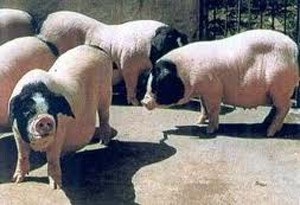
|
Jinhua Pigs are from the Zhejiang Province in China.The have a white body, with black at the head
and rump. This leads to the common name of two-end-black. Their
back and loins are slightly curved. They have thin skin, fine bones, and tender
meat.
Jinhua belong to a type of swine found in central China, the region
between the Changjiang and Zhujiang rivers where the climate is temperate (or
warm) and moist. Agriculture in this re
...
|
|
 Juliana Juliana
|
|
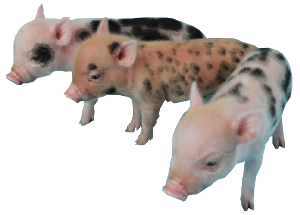
|
Juliana Pigs,
also known as Miniature Painted Pigs, are small colorful pigs. They are lean,
muscular pigs that originating in Europe through selective breeding of various
kinds of pigs. On average the Juliana pig weighs between 30 - 50 pounds and is
13 - 15 inches in height.
They have distinctive elongated snout. However, the main
advantage of these pigs is the temperament - during breeding, much attention
was paid not only to their
...
|
|
 Kakhetian Kakhetian
|
|
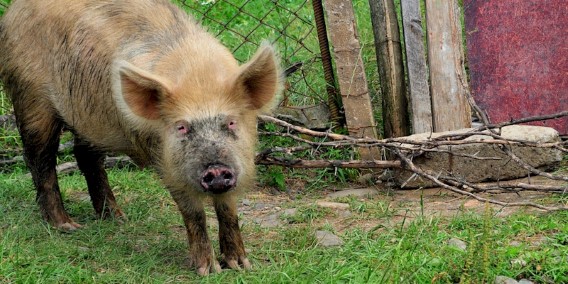
|
Originating from Kakheti, the picturesque eastern province of Georgia, Kakhetian Pigs stand as proud representatives of European swine breeds, revered for their unique characteristics and vital contributions to local husbandry traditions.
With their medium-size long heads, well-developed moving snouts, and short standing ears, Kakhetian Pigs present a striking silhouette against the backdrop of Kakheti's rolling hills and verdant lands
...
|
|
 Kele Kele
|
|
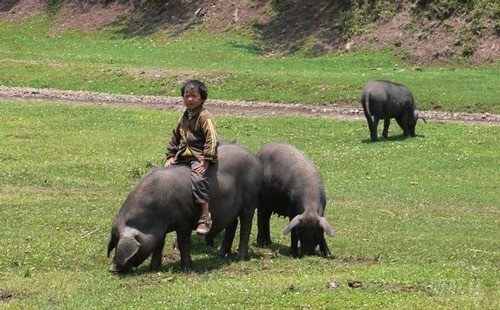
|
Kele Pigs are from Southwest China in the
Yunnan-Guizhou mountainous areas, where the altitude is between 1700 to 2400 m,
the climate is dry and cold during the winter, and humid in summer, and
characterized by erratic changes in weather. Kele pigs have exceptionally thick
back fat (5.1 to 7.2 cm) most likely because these pigs are bred for extra fat,
since people in mountainous areas have a special demand for fat in their diet.
...
|
|
 Kemerovo Kemerovo
|
|
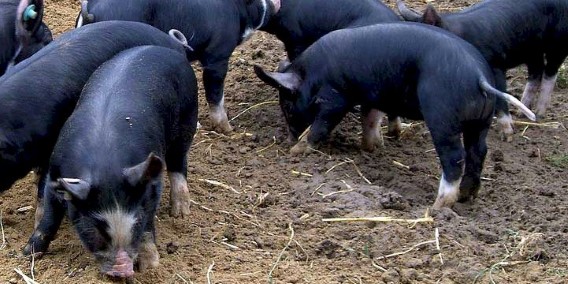
|
Kemerovo Pigs are a general-purpose pig breed from the Kemerovo
region of Russia. They were developed by the crossbreeding of local late-ripening
pigs with large white, white long-eared, Berkshire, Great Black and Siberian
northern breeds. In 1960 they were approved as an independent breed. The result
is a pig with good adaptability to cold temperatures, high rates of early
maturity, and large liters. The Kemerovo breed is divided into two t
...
|
|
 Korean Native Korean Native
|
|
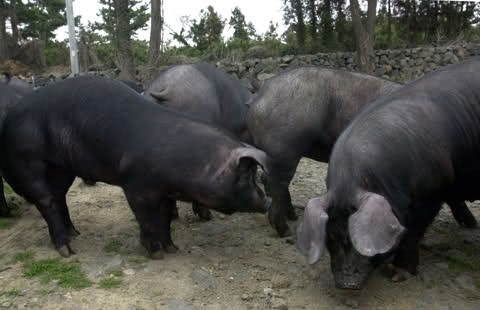
|
Korean native pigs are distinguished by their sleek black glossy hairs, characteristic caved face, and a notably protruded mouth complemented by large, expressive eyes. Their straightly upright ears add to their distinctive appearance, while their physique features a round shoulder, narrow rear, and wide chest, coupled with long hips and well-balanced short legs. Notably, they boast 10-12 teats, reflecting their reproductive prowess.
R
...
|
|
 Krskopolje Krskopolje
|
|
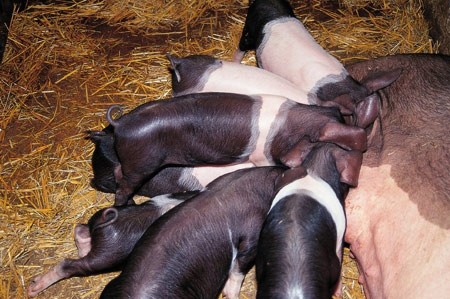
|
Krskopolje Pigs, affectionately known as Blackbelted pigs, hail from the picturesque Carniola and Styria regions of Slovenia, where they have long been cherished for their unique appearance and robust characteristics.
These distinctive pigs are easily recognizable by their striking black hindquarters adorned with a broad white stripe encircling their bodies like a belt. Their medium-length, flat heads are complemented by large, droopin
...
|
|
 KuneKune KuneKune
|
|

|
The KuneKune, a diminutive breed of domestic pig, is characterized by its compact, rotund build and a thick coat of hair that varies in color from black and white to ginger, cream, gold-tip, black, brown, and even tri-colored. Notably, some KuneKunes may sport wattles, small hanging pieces of flesh akin to a rooster's wattle, adding to their distinctive appearance.
Initially teetering on the brink of extinction, KuneKunes were once sol
...
|
|
 Lacombe Lacombe
|
|
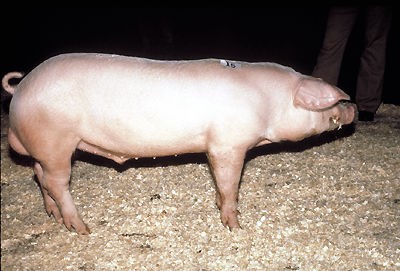
|
Lacombe Pigs are a breed of Canadian pig. They are
named after the Lacombe Research Centre in Lacombe, Alberta. They were the
first strain of livestock developed in the Canada.
Lacombe Pigs development began in 1947 with the
crossing of Berkshire sows to Danish Landrace and Chester White boars. The goal
was to produce a pig that would be appropriate for crossing with the Yorkshire,
the dominant breed in Canada at the time. The La
...
|
|
 Landrace Landrace
|
|
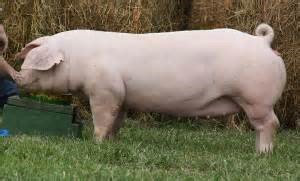
|
Landrace Pigs are found in many countries with small variations from country to country; however, they are all descended from hogs that were developed in Denmark.
The development of Landrace Pigs began in about 1895. It resulted from crossing Large White hogs from England with native pigs. . It was largely thanks to the use of Landrace pigs that Denmark became a great bacon-exporting country.
Landrace Pigs care tornAmerica i
...
|
|
 Lang Hong Lang Hong
|
|
|
Lang Hong pigs, also known as Langshan pigs, are an indigenous breed of domestic swine originating from the Shandong Province in China. They are characterized by their distinctive black and white markings, compact build, and hardy temperament.
Lang Hong pigs are considered medium-sized hogs, typically weighing between 180 and 250 kilograms (397 and 551 pounds) at maturity. Boars tend to be slightly larger than sows.
They ha
...
|
|
 Large Black Large Black
|
|
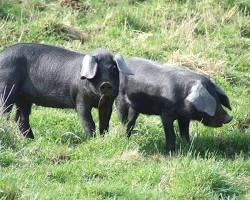
|
Large Black Hogs, occasionally called the Devon or
Cornwall Black, are a meet pig, originally from Great Britain, particularly
Devon, Cornwall, and Essex.
Large Blacks were developed from local black pig breeds
from the West Country and the East of England. With the founding of a breed
association in 1898 or 1899, variations between the types from the two areas
decreased. The Large Black was popular in the early 1900s and was exp
...
|
|
 Large White Large White
|
|
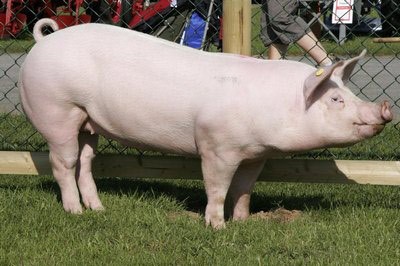
|
The Large White
is a breed of domestic pig originating in Yorkshire. They are one of the most
common pig breeds. Large Whites in the US are referred to as American
Yorkshires, or just Yorkshires.
As one would
expect Large Whites are large and white. They have erect ears and a dished
face.
They were originally
developed as an outdoor breed, but today they are favored by commercial pig
breeders.
First recognized
...
|
|
 Latvian white Latvian white
|
|
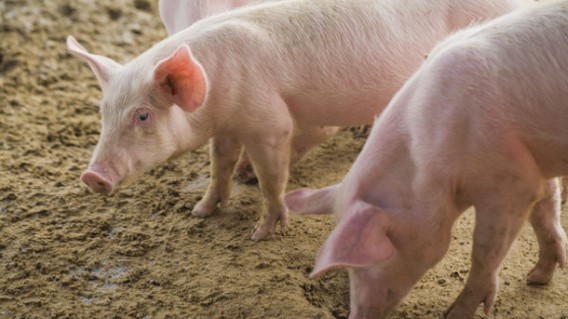
|
The Latvian White Pig is a domestic breed originating from Latvia, a country in the Baltic region of Europe. These pigs are renowned for their distinct white coat, which is their defining characteristic. They typically have a medium-sized build, with adult pigs reaching weights between 150 to 250 kilograms (330 to 550 pounds), depending on factors such as age, genetics, and diet.
Known for their adaptability and resilience, Latvian Whi
...
|
|
 Leicoma Leicoma
|
|
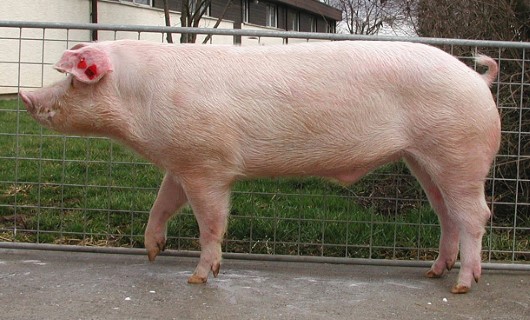
|
Leicoma pigs, an endangered breed hailing from East Germany, are characterized by their robust build, large frame, and distinctive hanging ears. Despite facing near-extinction, efforts by organizations like the IBV (Information and Coordination Centre for Biological Diversity) have led to a resurgence in breeding initiatives, with the breeding stock rising to 83 sows and 21 boars by 2019.
Renowned for their exceptional meat quality, L
...
|
|
 Liang Guang Liang Guang
|
|
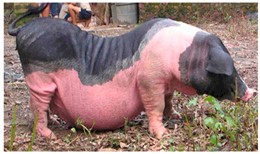
|
Liang Guang pigs, also known as Liangguang pigs, are an indigenous breed of domestic swine originating from the Guangxi Zhuang Autonomous Region and Guangdong Province in China. They are characterized by their distinctive black coloration, compact build, and hardy temperament.
Liang Guang pigs are considered medium-sized hogs, typically weighing between 180 and 250 kilograms (397 and 551 pounds) at maturity. Boars tend to be slightly
...
|
|
 Lincolnshire Curly-Coated Lincolnshire Curly-Coated
|
|
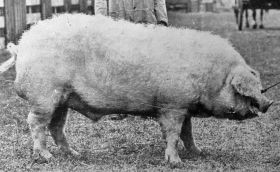
|
Lincolnshire Curly-Coated Pigs, also known as the
Baston Pigs or simply as the Lincolnshire Curly
Coats, were an old breed of pigs from Lincolnshire,
England. The breed became rare, and was finally extinct by the early to mid-1970s.
Lincolnshire Curly-Coated Pigs were bred
to be tough and hardy. They were large and had lop ears. Their most prominent
feature was their long, curly white coat, which helped it to weather the damp,
co
...
|
|
 Lithuanian Native Lithuanian Native
|
|
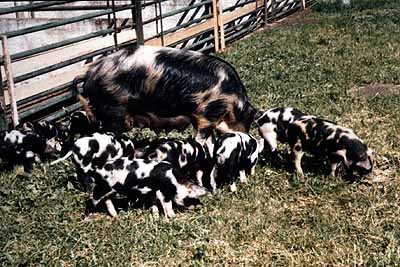
|
Lithuanian Native
Pigs are a rare middle-sized pig from Lithuania. They can be traced back to
ancient times, and they are one of the oldest pig varieties in Europe. It is a
middle-sized breed.
Lithuanian Native
Pigs typically have wattles on the neck, and usually they have large black
spots on their body, but color variations include black-and-white, ginger,
black, and tri-colored. They are friendly and they are not sensitive to the
...
|
|
 Lithuanian White Lithuanian White
|
|
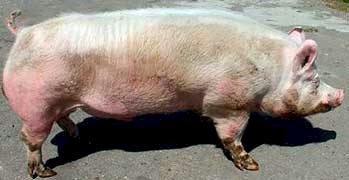
|
The Lithuanian White Pig stands as a standardized and versatile breed, meticulously developed through the amalgamation of various genetic strains, including the indigenous Lithuanian Native Pigs. Renowned for its adaptability and multifaceted utility, this breed embodies the culmination of careful breeding practices and centuries of agricultural tradition in Lithuania.
With a focus on versatility and functionality, the Lithuanian White
...
|
|
 Livny Livny
|
|
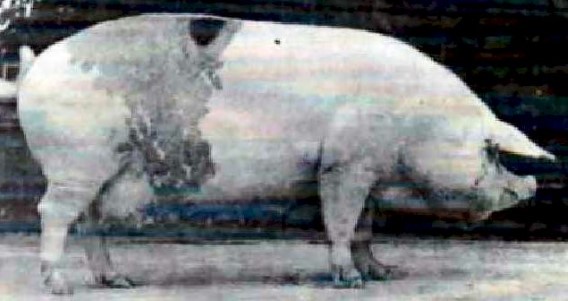
|
Livny Pigs are a general purpose pig from the Orel region of Russia. They
were developed by a team of specialists from the Livny Breeding Ground. Selective
pedigree work was carried out on the basis of the cross-breeding stock, which
was formed before 1917 by random outbreeding of local late-ripening pigs with
Berkshire, Large White, Middle White, and Polish-Chinese pigs.
As a result of monitoring 10 lines of boars and 28
breeding
...
|
|
 Luchuan Luchuan
|
|
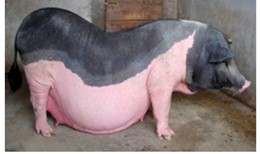
|
Luchuan pigs, also known as Ryukyuan pigs, are an indigenous breed of domestic swine originating from the Ryukyu Islands, Japan. They are characterized by their distinctive reddish-brown coloration, compact build, and hardy temperament.
Luchuan pigs are considered medium-sized hogs, typically weighing between 150 and 200 kilograms (331 and 441 pounds) at maturity. Boars tend to be slightly larger than sows.
They have a comp
...
|
|
 Malhado de Alcobaca Malhado de Alcobaca
|
|
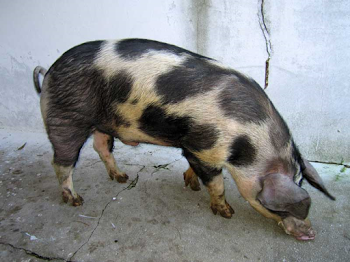
|
Malhado de Alcobaça pigs, a native Portuguese breed once feared to be extinct, have recently experienced a remarkable resurgence in numbers. This breed, characterized by its distinctive coloration and unique genetic heritage, has captured the attention of conservationists and pig enthusiasts alike.
Hailing from the region of Alcobaça in Portugal, these pigs boast a rich history deeply intertwined with the cultural heritage of their hom
...
|
|
 Mangalica Mangalica
|
|
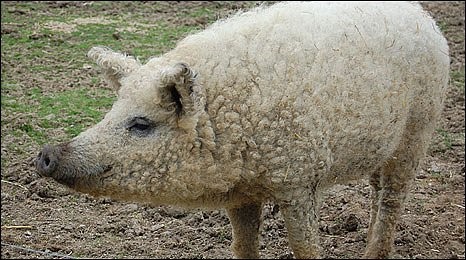
|
Mangalica Pigs (sometimes spelled Mangalitsa (USA) or
Mangalitza (UK)) is a Hungarian breed of pig that was developed in the 19th
century by cross-breeding the traditional Hungarian Bakonyi and Szalontai
breeds with imported Sumadia pigs from Serbia.
Mangalitsa pigs have a thick hairy coat similar to that
of a sheep. The only other pig breed noted for having a long coat is the
extinct Lincolnshire Curly Coat of England.
...
|
|
 Meishan Meishan
|
|
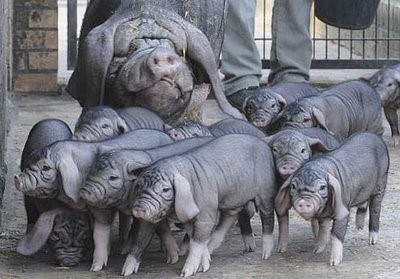
|
Meishan pigs are named for the
Chinese prefecture of Meishan. They are classified
as a type of Taihu pig which are all from the narrow region of mild
sub-tropical climate around the Taihu Lake region in Shanghai.
Meishan pigs are small to medium-sized with large
drooping ears and wrinkled black skin. They are best known for its large
litters of 15-16 piglets. Due to their fecundity, they were introduced into the
United States un
...
|
|
 Middle White Pig Middle White Pig
|
|

|
The Middle White Pig, a quintessential breed native to the United Kingdom, traces its roots back to Yorkshire, emerging around the same period as its counterparts, the Large White and the now-extinct Small White. The name "Middle White" aptly reflects its size, positioned between the larger Large White and the smaller Small White breeds.
Formally recognized as a distinct breed in 1884, the Middle White Pig has established itself as a n
...
|
|
 Minbei Spotted Minbei Spotted
|
|
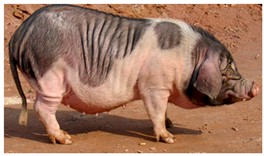
|
Minbei Spotted pigs, also known as Northwestern China Spotted pigs, are an indigenous breed of domestic swine originating from the Shaanxi Province and Gansu Province in China. They are characterized by their distinctive spotted coloration, compact build, and hardy temperament.
Minbei Spotted pigs are considered medium-sized hogs, typically weighing between 180 and 230 kilograms (397 and 507 pounds) at maturity. Boars tend to be slight
...
|
|
 Minzhu Minzhu
|
|
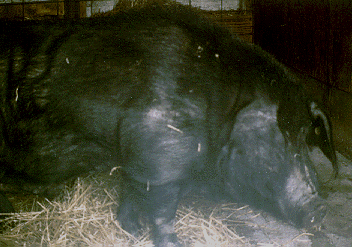
|
Minzhu pigs, or
Ming, Min, or Da Min, pigs come from far northern China. Minzhu means folk pig.
They can be found
in the Middle Temperate Belt, to the north of the Huaihe River Basin and the
Qinling Mountains. The cold and dry climate of this region makes the Minzhu
very tolerant to cold temperatures and harsh feeding conditions. They are also
known as the Ming, Min, or Da Min. Minzhu is said to mean folk pig.
Minzhu pi
...
|
|
 Moara Moara
|
|
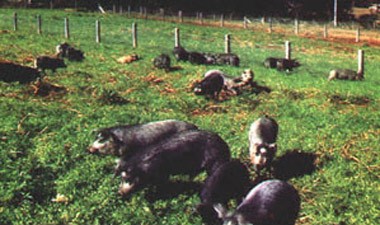
|
The Moara Pig, also recognized by names such as Estrela, Estrelense, Mouro, and Pereira Pig, hails from the regions of Duroc, Canastra, and Canastrao in southern Brazil. Sporting a distinctive blue roan coat, although occasionally displaying a red roan hue, these pigs boast a unique and eye-catching appearance.
Renowned for their resilience and durability, Moara Pigs are esteemed for their toughness and strength. They exhibit a remarka
...
|
|
 Mong Cai Mong Cai
|
|
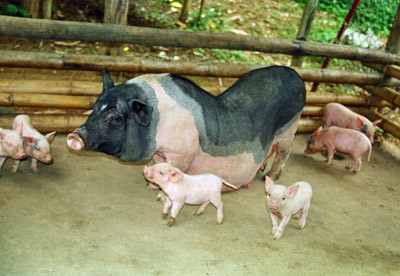
|
Mong Cai Pigs are one of the most common breeds of Pigs in northern
Vietnam, particularly in the provinces of North Mountain area, the Red River
delta, and the northern part of the Central Coastline.
Mong Cai Pigs are small to medium sized. Their heads are black with
small and upright ears. Black patches are also found other places on their body
with a white band running from one side of their abdomen over the shoulder to
other s
...
|
|
 Mora Romagnola Mora Romagnola
|
|

|
Mora Romagnola
Pigs are from Emilia-Romagna, in northern Italy.
In the early 20th
century there were several similar but distinct regional sub-types of Romagnolo
pigs, including the Forlivese from the area o Forli, the Faentina from the area
of Faenza and the Riminese or Mora Riminese from the area of Rimini. From the
beginning of the century all of these types began to be crossed with British
Yorkshire pigs, which were first im
...
|
|
 Mukota Mukota
|
|
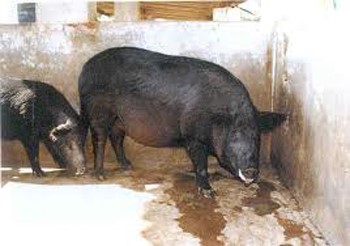
|
Mukota Pigs, also
known as the Rhodesian Indigenous or Zimbabwe Indigenous pigs, are primarily
found in Zimbabwe, but they also are found in Mozambique and Zambia.
Mukota pigs are
black, hardy in the tropics, resistant to disease and poor nutrition, and
require little water (6 liters per week). They fall into two broad classes. One
is short and fat, with a short snout resembling that of the Chinese Lard pig.
The other resembles
...
|
|
 Mulefoot Mulefoot
|
|
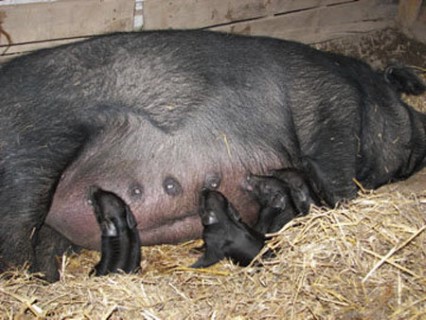
|
The Mulefoot pig, a rare and robust American swine breed, stands out for its hardiness and adaptability. Typically donning a sleek black coat, although occasionally featuring white markings, these pigs boast an average weight range of 400 to 600 pounds (180 to 270 kg). Males tend to tip the scales at around 550 pounds (250 kg), while females weigh in at approximately 450 pounds (200 kg).
Thriving in pasture-based environments rather th
...
|
|
 Murom Murom
|
|
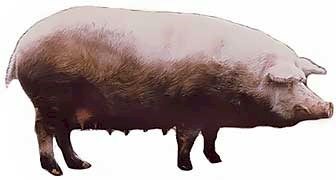
|
Murom Pigs are a meat and lard breed of hogs developed
in 1957 in Murom Raion, Vladimir Oblast by selection of a domestic breed.
Murom Pigs are large, sturdy, and well built. Mature
boars weigh 250 - 280 kg; sows weigh 200 - 220 kg. A litter consists of ten or
11 shoats; the sow’s milk production is 60 - 70 kg. When fattened for meat, a
pig at six or seven months of age will weigh 90 - 100 kg and produce high-quality
bacon on the
...
|
|
 Myrhorod Myrhorod
|
|
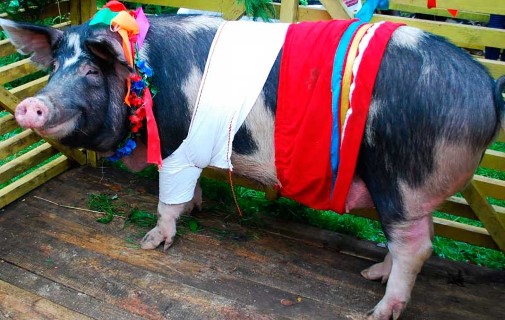
|
Myrhorod Pigs are a lard-type pig breed from Ukraine. They were the second domestic breed of
pig developed in Russia. Myrhorod Pigs are the result of prolonged planned work
by a large collective of scientists, specialists, and workers of collective and
state farms. They were developed through crossing of local black-ruffled pigs
with Berkshire, medium white, partially large white, Temvorskaya, and large
black pigs.
Boars have an a
...
|
|
 Nebrodi Nebrodi
|
|

|
This breed is
also called Nebrodi or Madonie black
swine. The presence
in Sicily of black swine is testified by the references of ancient writers, and
verified in the Greek-Carthage period (VII-VI cent. B.C.). It is rustic, almost
wild, always grazing in the woods, as fossil remains testify.
Today only some
limited examples of this breed are reared wild in Madonie and Nebrodi
mountains.
Precocious and long-lived breed i
...
|
|
 Neijiang Neijiang
|
|
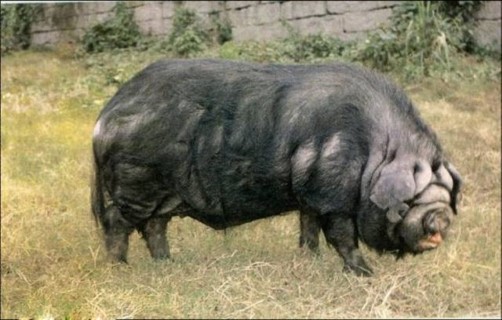
|
Neijiang Pigs, renowned for their large size, thrive in the mild climate and fertile agricultural landscapes of Southwest China's Sichuan Basin. This region boasts well-developed agriculture and abundant feed resources, providing an optimal environment for the rearing of these robust pigs. With ample access to nutritious feed and favorable climatic conditions, Neijiang Pigs flourish, contributing to the rich agricultural heritage of the area.
|
|
 Ningxiang Ningxiang
|
|
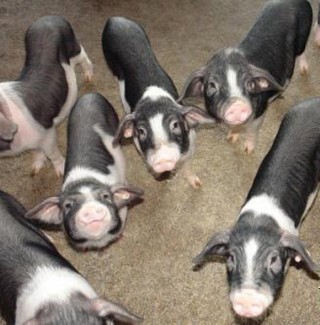
|
Ningxiang Pigs, originating from the Hunan Province of China nestled within the Central Subtropic belt, are renowned as lard pigs with distinctive features. These pigs are typically nurtured and fed by hand throughout the year, reflecting the meticulous care they receive from their handlers.
Their striking appearance is marked by a unique hair coat color pattern, often likened to "black clouds overhanging snows" with a distinguished si
...
|
|
 North Caucasian North Caucasian
|
|
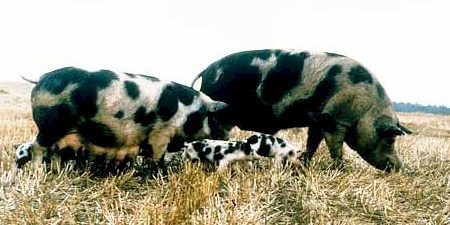
|
North Caucasian Pigs are a
general purpose pig breed from Russia and Uzbekistan.
At that time in the North
Caucasus, the local Kuban pigs were bred mainly with strong constitution and
adaptability to local conditions and pasture content, satisfactory multiparty
and good maternal qualities. However they were slow to mature. Therefore, it
was decided to keep everything valuable from local Kuban pigs, but with early
maturity and im
...
|
|
 North Siberian North Siberian
|
|
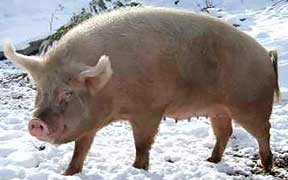
|
North Siberian Pigs are a
medium sized general purpose pig breed from Russia. They were developed in
Novosibirsk Oblast in Russia in the 1940s. They were developed by crossing the
short-eared Siberian pigs with Large White boars; the North Siberian was bred
for a dense bristle covering and undercoat to increase hardiness to the harsh
climate of northern Siberia. Adult males typically reach 312kg in size.
The North Siberian is a
w
...
|
|
 Norwegian Landrace Norwegian Landrace
|
|
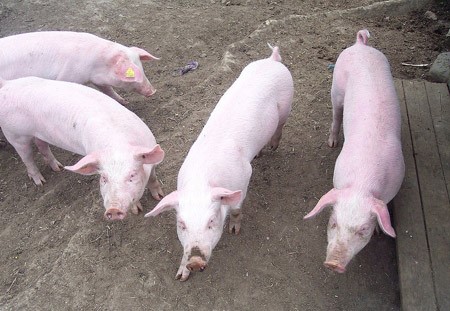
|
Norwegian Landrace Pigs are the leading breed of swine
in Norway. They are white and have a heavy drooped ear.
Since swine are not as numerous in Norway as in most countries
that have a registered strain, the number registered each year is limited.
Norwegian Landrace, as well as most of the swine in Norway, are raised in the
southern part of the country. Most are found in the area of Hamar.
Norwegian Landrace Pigs origin
...
|
|
 Ossabaw Island Ossabaw Island
|
|
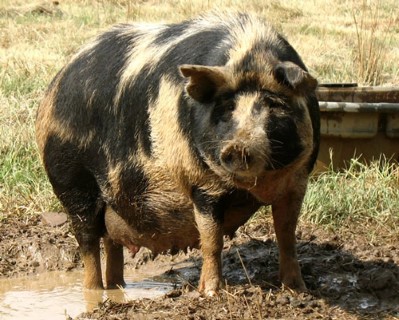
|
Ossabaw Island hogs, or Ossabaw Island pigs, is a breed of pig derived from a population of feral pigs on Ossabaw Island, Georgia, United States. The original Ossabaw hogs are descended from swine released on the island in the 16th century by Spanish explorers. A breeding population has been established on American farms off the island, but they remain a critically endangered variety of pig.
Originally, Ossabaw Island pigs were small
...
|
|
 Oxford Sandy Oxford Sandy
|
|
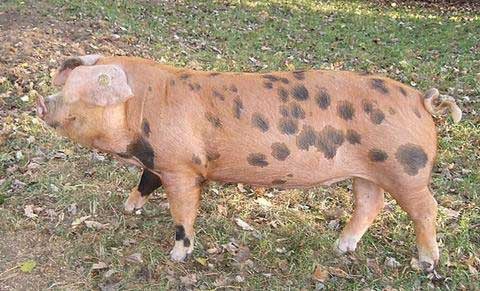
|
Oxford Sandy and Black Pigs originated in Oxfordshire, UK. Named for its
color, which is a base of sandy brown with black patches, the breed is also
sometimes called the Plum Pudding or Oxford Forest pig Related to the old
Berkshire and Tamworth breeds, they are one of the oldest pigs native to
Britain.
Oxford Sandy and Black are a hardy, docile pig suited to being reared
outdoors, where its color protects it from sunburn (which
...
|
|
 Parma Parma
|
|

|
Parma swine
breeding historically represents a deep-rooted documented activity since the
end of 1400. At that time black coated pigs were particularly appreciated as
they reached a considerable weight (190-240 kg). From the second half of the
nineteenth century onwards, black pigs were gradually replaced by white stock
from northern Europe, as they were more productive and profitable. But since
the half of the 90s a recovery plan of the bla
...
|
|
 Philippine Wild Philippine Wild
|
|
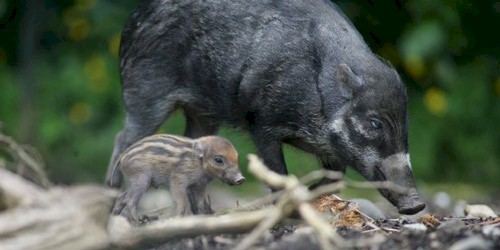
|
The Philippines stands out for its rich biodiversity, particularly in the realm of wild pigs, boasting an impressive four endemic species. This distinction places the Philippines in a unique position, possibly hosting the largest number of endemic wild pig species among nations.
Remarkably, the islands of Tawi-Tawi, situated near Sabah, Malaysia, and Tablas in the central Philippines, are home to two distinct populations of wild pig sp
...
|
|
 Pietrain Pietrain
|
|
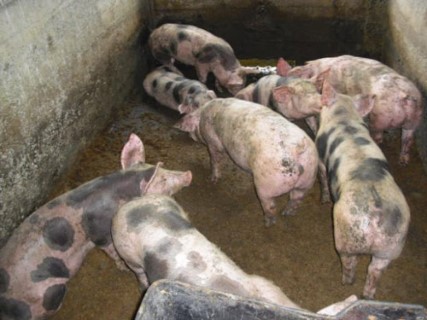
|
Pietrain Pigs, originating from Pietrain, France, a quaint village situated within the Walloon municipality of Jodoigne, rose to prominence during the challenging period of the 1950s, marked by significant volatility in the swine market. Their distinctive characteristics and qualities quickly garnered attention and acclaim, leading to their importation into Germany in the early 1960s.
Germany swiftly became a hub for Pietrain pig breed
...
|
|
 Pingxiang Pingxiang
|
|
|
Pingxiang pigs, also known as Pingxiang Black pigs, are an indigenous breed of domestic swine originating from the Pingxiang City in Guangxi Zhuang Autonomous Region, China. They are characterized by their distinctive black coloration, compact build, and hardy temperament.
Pingxiang pigs are considered medium-sized hogs, typically weighing between 180 and 250 kilograms (397 and 551 pounds) at maturity. Boars tend to be slightly larger
...
|
|
 Poland China Poland China
|
|
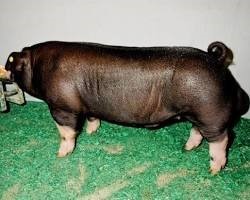
|
The Poland China pig, named after the Hankinson Farm in Blue Ball, Warren County, Ohio where it was first bred in 1816, is a distinguished American breed renowned for its meat production prowess. Hailing from the Miami Valley, Butler, and Warren counties in Ohio, these pigs boast a commanding presence with their big-framed, long-bodied, lean, and muscular build, earning them a leading role in U.S. pork production in pounds of hog per sow per year
...
|
|
 Prestice Black Pied Prestice Black Pied
|
|
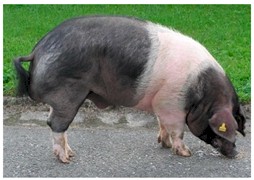
|
Prestice Black Pied pigs are an indigenous breed of swine originating from the western region of the Czech Republic. They are characterized by their distinct black and white markings and their generally gentle temperament. Prestice Black Pied pigs are classified as medium-sized hogs, typically weighing between 215 and 280 kilograms (474 and 617 pounds) at maturity. Their build is compact and muscular, with a slightly arched back and a deep chest.
...
|
|
 Pugliese Pugliese
|
|

|
According to the
opinion of last centurys reliable authors Pugliese swine differ from other
breeds in height, strength, sobriety and rustic nature.
Thanks to a plan
to the recovery of the breed some rustic pigs (mainly black) were found on the
territory; today they are reared in the wild state.
The skin was
covered by big black bristles, sometimes black with tawny markings, washed away
in the tip, especially on the bac
...
|
|
 Qianshao Spotted Qianshao Spotted
|
|
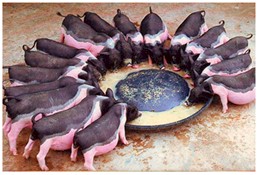
|
Qianshao Spotted pigs, also known as Qiannan Spotted pigs, are an indigenous breed of domestic swine originating from the Qiannan Autonomous Region in China. They are characterized by their distinctive spotted coloration, compact build, and hardy temperament.
Qianshao Spotted pigs are considered medium-sized hogs, typically weighing between 180 and 230 kilograms (397 and 507 pounds) at maturity. Boars tend to be slightly larger than s
...
|
|
 Red Boar Red Boar
|
|
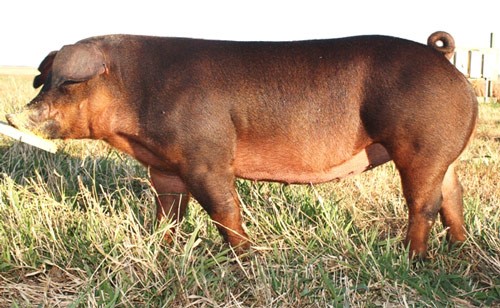
|
In 1823, a red boar, whose parents were probably taken
from England, was obtained by Isaac Frink of Milton in Saratoga, New York.
Frink had obtained the boar from a man named Harry Kelsey. Kelsey owned a
famous trotting stallion, named Duroc, and Frink named his red boar in honor of
that horse. That boars progeny continued the Duroc pig name and many of his
offspring inherited his color, quick growth and maturity, deep body, sturdy ham
and
...
|
|
 Red Wattle Red Wattle
|
|
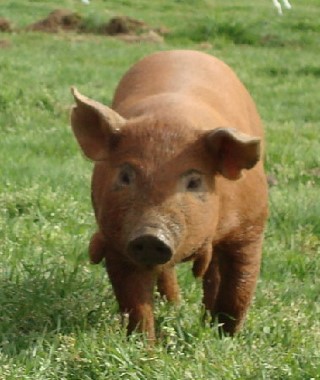
|
The Red Wattle hog, also known as the Red Wattle pig, stands as an emblem of American meat pig breeds, characterized by its striking red coat and distinctive wattles or tassels that adorn its face. These unique features set them apart in the world of swine.
Typically ranging from 600 to 800 pounds (270 - 360 kg) in weight, with some large specimens reaching a remarkable 1,200 pounds (540 kg), standing at 4 feet (120 cm) tall and stretc
...
|
|
 Rotbuntes Husumer Rotbuntes Husumer
|
|
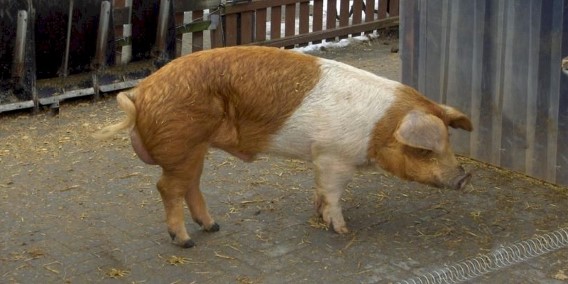
|
Rotbuntes Husumer pigs, also known as Red-and-White Husumer pigs, are a distinctive breed hailing from the picturesque region of Husum in northern Germany. Renowned for their striking red-and-white coat pattern, these pigs captivate with their unique appearance and robust build.
With roots tracing back to the lush landscapes of Husum, Rotbuntes Husumer pigs have evolved to thrive in the region's diverse environmental conditions. Their
...
|
|
 San Juan San Juan
|
|
|
San Juan pigs, indigenous to the picturesque island of Puerto Rico, embody resilience and adaptability in their genetic makeup. These hardy creatures thrive in diverse environments and varied feed conditions, showcasing their remarkable ability to adjust to changing surroundings.
Sporting a sleek black or dark brown coat adorning their medium-sized bodies, San Juan pigs boast a distinctive broad snout, adding to their unique charm. Ren
...
|
|
 Sarda Sarda
|
|

|
Sarda Pigs, originating from the picturesque island of Sardinia in Italy, epitomize the rugged charm of their homeland. Resembling their wild boar counterparts, with whom they often intermingle in the lush underbrush and scrublands where they graze, these pigs have been officially recognized as one of Italy's indigenous swine breeds since 2006.
These pigs boast a compact stature, reaching a mature weight of 70-100 kg. Their coats exhib
...
|
|
 Semirechye Semirechye
|
|
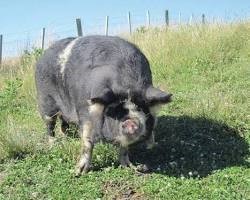
|
Semirechye pigs, originating from Kazakhstan, are a versatile and adaptable breed known for their ability to serve various purposes in agricultural settings.
These pigs, known as "Semirechye" which translates to "Seven Rivers" in reference to the region they come from, are valued for their versatility and hardiness. They are well-suited for a range of tasks, making them a popular choice among farmers for both meat and other agricultura
...
|
|
 Shaziling Shaziling
|
|
|
Shaziling pigs, also known as Shazi pigs, are an indigenous breed of domestic swine originating from the Shazi Township in Hunan Province, China. They are characterized by their distinctive black and white markings, compact build, and hardy temperament.
Shaziling pigs are considered medium-sized hogs, typically weighing between 180 and 250 kilograms (397 and 551 pounds) at maturity. Boars tend to be slightly larger than sows.
...
|
|
 Siberian Black Pied Siberian Black Pied
|
|
|
Siberian Black Pied Pigs, hailing from Russia, have a unique origin story intertwined with the development of the North Siberian breed. Initially emerging from stock that did not meet the criteria for the North Siberian lineage, these pigs were carefully cultivated to form a distinct breed known as the Siberian Black Pied.
Primarily concentrated in the Novosibirsk region, their population has fluctuated between 4,000 to 12,000 since th
...
|
|
 Small Black Small Black
|
|
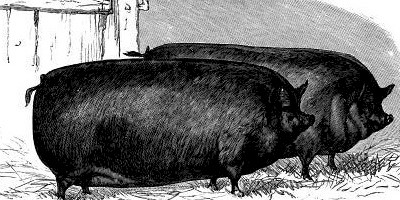
|
Small Black, or Suffolk, Pigs are extinct pigs from the United Kingdomduring the nineteenth century.
Their origin is uncertain, but mostly likely there were a cross between
Essexpigs and foreign breeds in efforts to
improve it. The Small Black closely resembled the, also now extinct, Small
White, except they were black and had pricked ears and a short upturned snout -
which indicates a contribution from imported Chinese pigs.
|
|
 Small White Small White
|
|
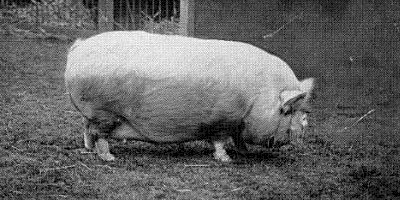
|
The Small White, also known as Small Yorkshire, Pigs, were a notable breed originating in the United Kingdom, prominent during the nineteenth century. This breed, although now extinct, played a significant role in the development of modern swine breeds, including the Middle White and others, by contributing its distinctive characteristics.
These pigs were renowned for their compact size and robust build, making them well-suited for var
...
|
|
 Super Pigs Super Pigs
|
|
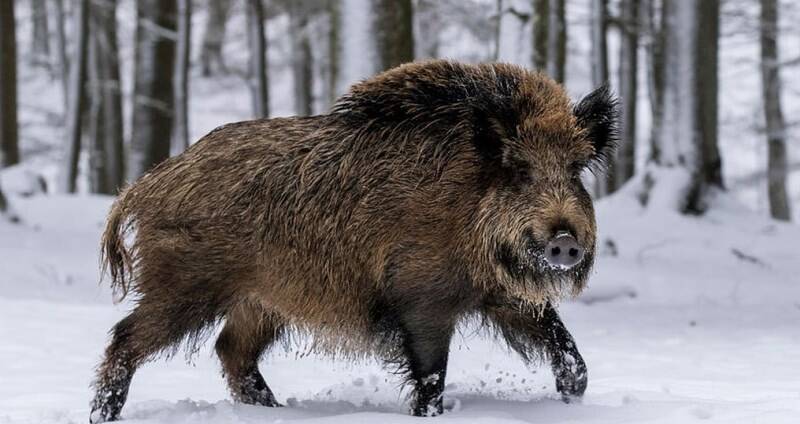
|
Super Pigs is not a singular breed, but a diverse mix of escaped domestic pigs and their descendants, have woven themselves into the fabric of the continent's landscapes.
Their story begins with domestication. European breeds like Yorkshires and Berkshires, brought across the Atlantic, thrived in farmyards, their offspring carefully bred for size and temperament. But some rebelled, finding freedom in fields and forests. These escapee
...
|
|
 Swabian-Hall Swabian-Hall
|
|
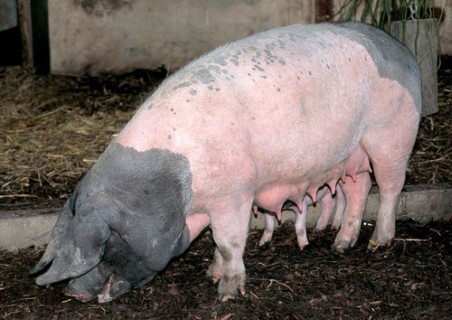
|
Swabian-Hall Pigs originating from Schwabisch Hall in Baden-Württemberg,
Germany. They are a large pig, white in the center with a black head and rear
and narrow grey bands at the transition from white to black skin. They have
large litters averaging more than nine piglets.
They are the result of King Wilhelm going to
China and obtaining Meishan Swine and then crossbreeding them with Russian Wild
Boar that was indigenous to the co
...
|
|
 Swedish Landrace Swedish Landrace
|
|
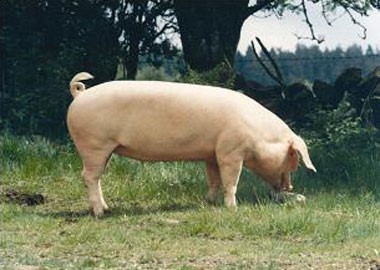
|
Swedish Landrace Pigs stand as the foremost breed of pig in Sweden, boasting distinctive heavy drooping ears and a pristine white coat. Originating from importations primarily from neighboring Denmark, the Swedish strain of the Landrace pig has flourished and adapted to its Scandinavian habitat.
These pigs are recognized for their robust build and adaptable nature, making them well-suited to various farming systems and environmental co
...
|
|
 Taihu Taihu
|
|
|
Taihu Pigs, native to the serene landscapes surrounding the Taihu Lake region in the lower Yangtze River Valley of China, boast a distinct set of characteristics that set them apart. These large, ebony-colored pigs feature a prominently wrinkled face, adding to their unique appearance. With a broad forehead and generously folded ears, they possess a commanding presence.
Renowned for their robust reproductive capabilities, Taihu strains
...
|
|
 Tamworth Tamworth
|
|
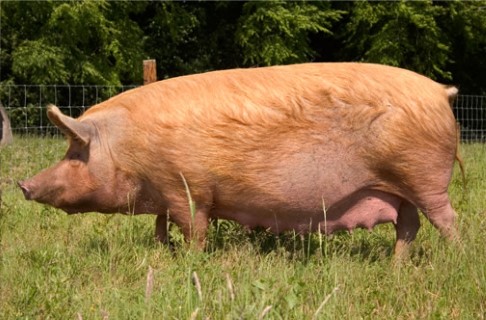
|
Tamworth Pigs, also known as Irish Grazers, are revered for their distinct ginger to red-colored coats and hail from the Tamworth region in the UK, as well as from Ireland. As one of the oldest pig breeds, they boast a rich heritage that dates back centuries. However, despite their historical significance, Tamworth Pigs face challenges in adapting to modern production methods commonly employed in the livestock industry.
Characterized b
...
|
|
 Thuoc Nhieu Thuoc Nhieu
|
|
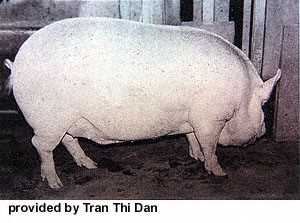
|
The Thuoc Nhieu Pig, a breed with origins rooted in the crossbreeding of Bo Xu and Yorkshire Pigs spanning the period from 1930 to 1957, boasts a distinct appearance characterized by its white coat adorned with piebald bristles.
These pigs have carved out a dominant presence in the sweet-water zones of the Mekong River delta in the southern region of Vietnam. Exhibiting average prolificacy, Thuoc Nhieu Pigs typically give birth to 8 to
...
|
|
 Tibetan Tibetan
|
|
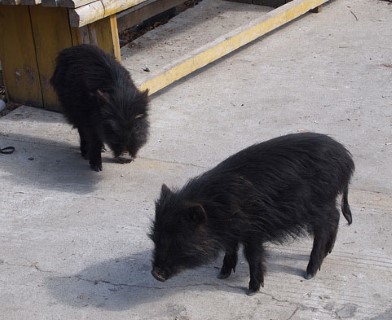
|
Tibetan Pigs, from the Qinghai-Tibet Plateau, are especially adapted to
the high, cold climate and to being on pasture all year round. Their meat has a
marble appearance and meat with a special flavor.
Tibetan Pigs are not very heavy (about 35 kg in mature animals.). They
are known to be very alert -often running and jumping, with quick responses for
guarding against attack from other animals.They have a narrow head and a long str
...
|
|
 Tokyo-X Tokyo-X
|
|
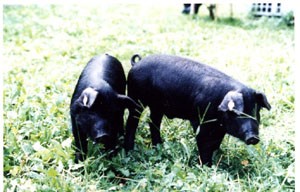
|
Tokyo-X Pigs are a new Japanese
hybrid premium-quality pig breed.
They were well known for its marbled meat, seldom seen in pork.
The Tokyo-X breeding effort was
begun in 1990 by the Tokyo Metropolitan Livestock Experiment Station, combining
bloodlines from the Duroc (USA), Berkshire (UK), and Beijing Black (China)
breeds. Five generations of breeding and selection ended in 1997 when the breed
went to market.
Tokyo-X P
...
|
|
 Tongcheng Tongcheng
|
|
|
Tongcheng pigs, also known as Two-Ends Black pigs, are an indigenous breed of domestic swine originating from Tongcheng County in Hubei Province, China. They are characterized by their distinctive black and white markings, compact build, and hardy temperament.
Tongcheng pigs are considered medium-sized hogs, typically weighing between 150 and 200 kilograms (331 and 441 pounds) at maturity. Boars tend to be slightly larger than sows.
...
|
|
 Tsivilsk Tsivilsk
|
|
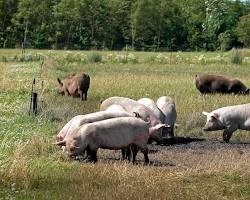
|
Tsivilsk Pigs are a distinctive breed hailing from Tsivilsk, Russia, a quaint town nestled within the Chuvash Republic. Situated in the heart of Russia, Tsivilsk serves as the birthplace and home to these remarkable pigs, known for their unique characteristics and contributions to the local agricultural landscape.
|
|
 Tunchang Tunchang
|
|
|
Tunchang pigs, also known as Tunchang black pigs, are an indigenous breed of domestic swine originating from the Tunchang County in Henan Province, China. They are characterized by their distinctive black coloration, compact build, and hardy temperament.
Tunchang pigs are considered medium-sized hogs, typically weighing between 180 and 250 kilograms (397 and 551 pounds) at maturity. Boars tend to be slightly larger than sows.
<
...
|
|
 Turopolje Turopolje
|
|
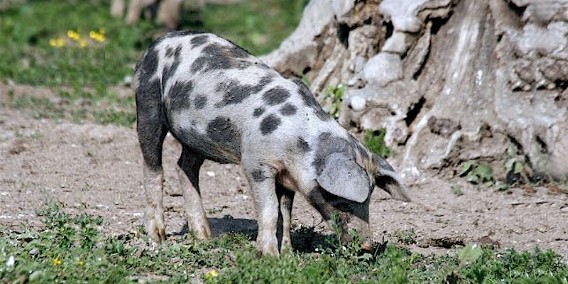
|
Turopolje pigs are from Turopolje, Croatia. They are distinctive-looking
swine, with black spots on their white or grey skin and drooping ears. They are
very rare, and are likely nearing extinction.
They are one of the older breeds of European pigs, though they may have
had infusions of Berkshire or other bloodlines in the 19th century.
Although Turopolje pigs are relatively small and not fast growing, they
are known for
...
|
|
 Ukrainian Steppe Speckled Ukrainian Steppe Speckled
|
|
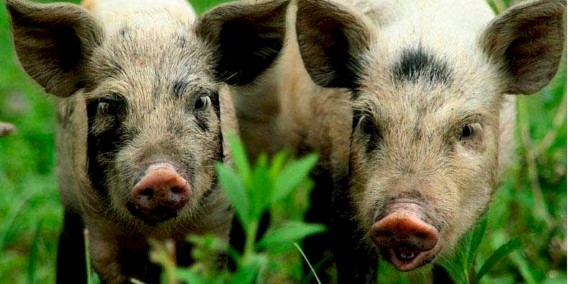
|
The Ukrainian Steppe Speckled Pig, prized for its dual-purpose suitability in meat and lard production, stands as a testament to resilience and adaptability in the arid plains of Ukraine. With a robust physique and formidable presence, these majestic creatures embody strength and endurance, thriving in the harsh conditions of the Ukrainian steppe.
Adult male specimens of the Ukrainian Steppe Speckled Pig typically exhibit impressive di
...
|
|
 Ukrainian White Steppe Ukrainian White Steppe
|
|
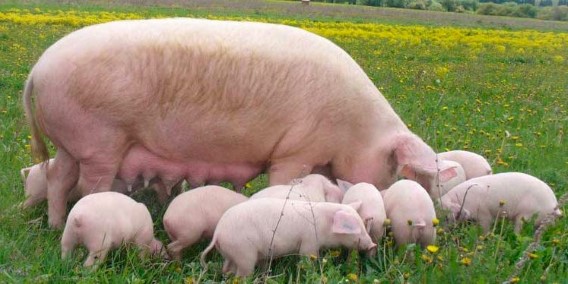
|
The Ukrainian White Steppe Pig, a versatile breed hailing from Ukraine, stands out for its remarkable adaptability and robustness, particularly well-suited to the arid landscapes of southern Ukraine. Notably, these pigs exhibit a high resistance to diseases, contributing to their enduring popularity among local farmers.
The breed traces its origins to the visionary efforts of M. F. Ivanov, who embarked on a breeding program between 192
...
|
|
 Urzhum Urzhum
|
|
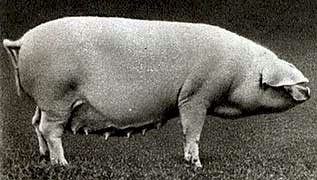
|
The Urzhum pig, originating from the Kirov region of Urzhum, Russia, emerged in the late 1950s through a meticulous breeding program that involved extensive crossbreeding of local pig strains with boars of the Large White variety. This deliberate hybridization process aimed to develop a swine breed that could thrive in the local climate while exhibiting superior meat qualities suitable for intensive pork production.
Renowned for their
...
|
|
 Vietnamese Potbelly Vietnamese Potbelly
|
|
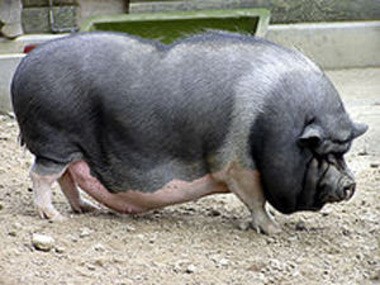
|
Vietnamese Potbelly Pigs are considerably
smaller than standard American or European farm pigs, they weigh 43 to 136 kg
(100 to 300 lb). Boars become fertile at six months of age, long before they
are completely physically mature. Pot-bellied pigs are considered fully grown
by six years of age, when the epiphyseal plates in the long bones of the legs finally
close.
Because pot-bellied pigs are the same species as ordinary farmyard
...
|
|
 Welsh Welsh
|
|
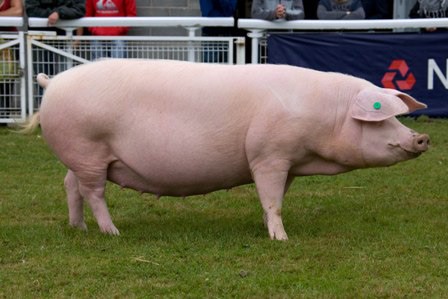
|
Welsh Pigs, distinguished by their robust build and distinctive pear-shaped physique, are renowned for their resilience in extensive farming practices, particularly in the rugged landscapes of Wales.
Originating in the 1870s, Welsh Pigs quickly gained recognition as a valuable breed within the United Kingdom, ranking as the third most prevalent sire breed, following the Large White and British Landrace varieties. Despite their proven a
...
|
|
 Wessex Saddleback Wessex Saddleback
|
|
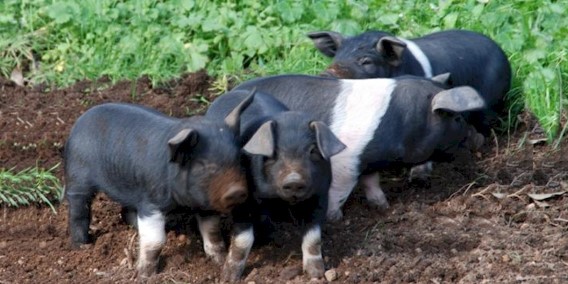
|
Wessex Saddleback Pigs, or Wessex Pig, are from the West Country of
England, (Wessex), particularly in Wiltshire and the New Forest area of
Hampshire. They are black, with white forequarters.
In Britain Wessex Saddlebacks were bred with Essex pigs to form the
British Saddleback, and as a result Wessex Saddleback are currently extinct as
a separate breed in Britain. However, the Wessex Saddleback survives in
Australia and New Zeala
...
|
|
 West French White West French White
|
|
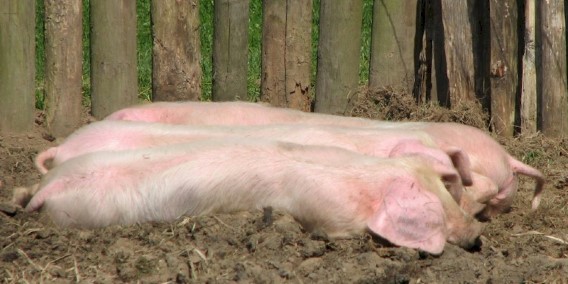
|
The West French White Pig, affectionately known as the "white pig of the West," emerged from the vibrant fusion of local pig varieties with esteemed breeds hailing from Normandy, Craonnaise, and Flamandes in the year 1958. This deliberate amalgamation resulted in the creation of a distinctive swine breed renowned for its remarkable attributes.
Boasting a robust physique, West French White Pigs command an impressive size, with adults re
...
|
|
 Windsnyer Windsnyer
|
|
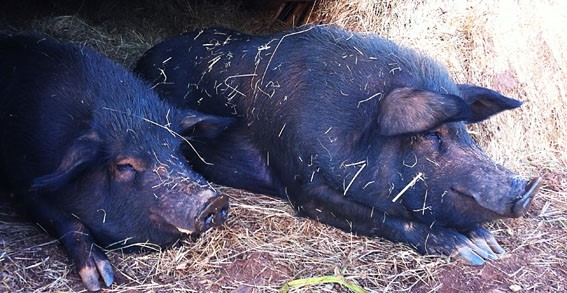
|
Windsnyer pigs, hailing from Zimbabwe, derive their name from their distinctive physical attributes – their narrow-bodied build and elongated noses, reminiscent of a "wind-cutter." This unique morphology reflects their adaptability to the local environment and foraging habits.
Renowned for their hardiness, Windsnyer pigs are adept scavengers, capable of sourcing their food from various sources, including sparse or low-nutrient environm
...
|
|
 Wuzhishan Wuzhishan
|
|
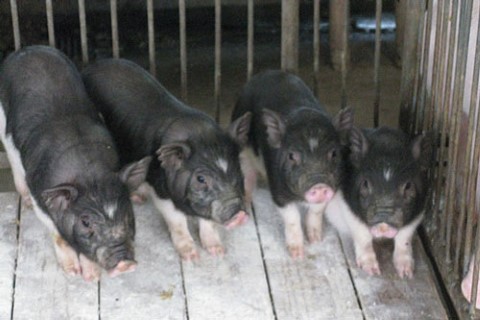
|
Wuzhishan Pigs are small pigs raised only in the isolated tropical
mountainous region of the Hainan province of China. Very few people in this
region raise this breed for production purposes because of the fast
introduction of exotic species. And Wuzhishan Pigs are not used as a market
supply animal, but only by local farmers for self-consumption. Together this is
leading to Wuzhishan Pigs becoming rare.
Wuzhishan pigs are black,
...
|
|
 Yanan Yanan
|
|
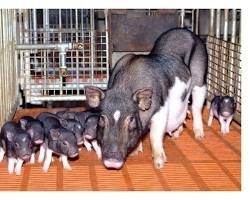
|
Yanan Pigs hail from the picturesque western Sichuan Basin hilly region in China, where they thrive amidst elevations ranging from 800 meters to 400 meters. This idyllic setting is characterized by a mild climate and abundant rainfall, providing the perfect environment for these remarkable animals to flourish.
Distinguished by their striking black coats and large, elongated bodies, Yanan Pigs possess a distinctively robust and stately
...
|
|
 Yorkshire Yorkshire
|
|

|
Yorkshire pigs are one of the most common
pig breed in North America. They are white and have upright ears. Black spots
are not permitted. While the Yorkshire breed comes in three distinct sizes --
small, medium and large -- only the latter is traditionally found in the American
pork industry. They are an extremely muscular pig and the typical Yorkshire
carcass contains a great deal of lean meat, with little fat on the back.
The Y
...
|
|
 Yorkshire England Yorkshire England
|
|
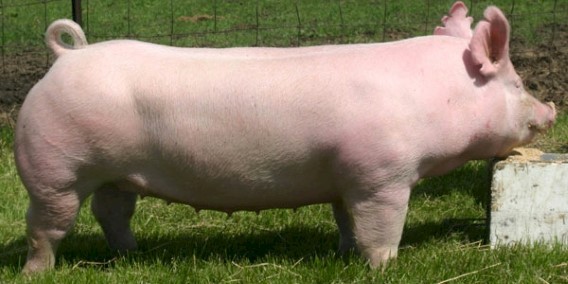
|
Originally from Yorkshire England, the Australian Yorkshires were derived from the
original English breed of domesticated pig. This
particular breed is also known as the most common breed in Australia.
In 2001, a study
was conducted at the Institute of Agricultural Sciences of South Vietnam that
compared the Australian Yorkshire and the Duroc to common Vietnamese pigs. It concluded that the
Australian breeds had a significant adva
...
|
